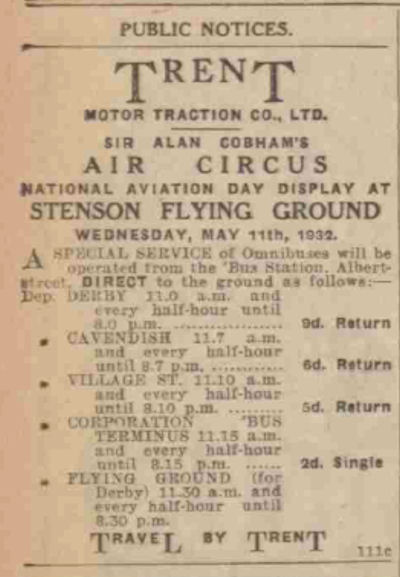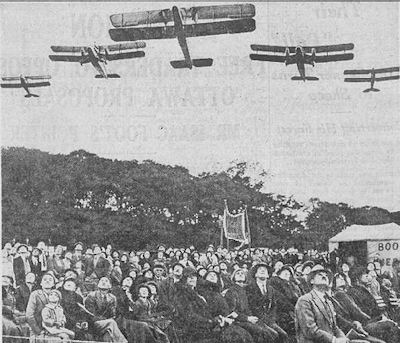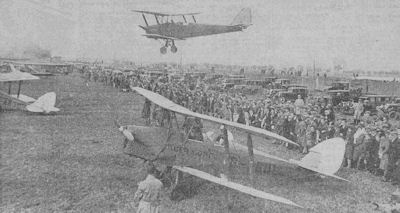Cobham's Air Circus
-
-Cobham Air Circus
The Cobham Air Circus 1932-35

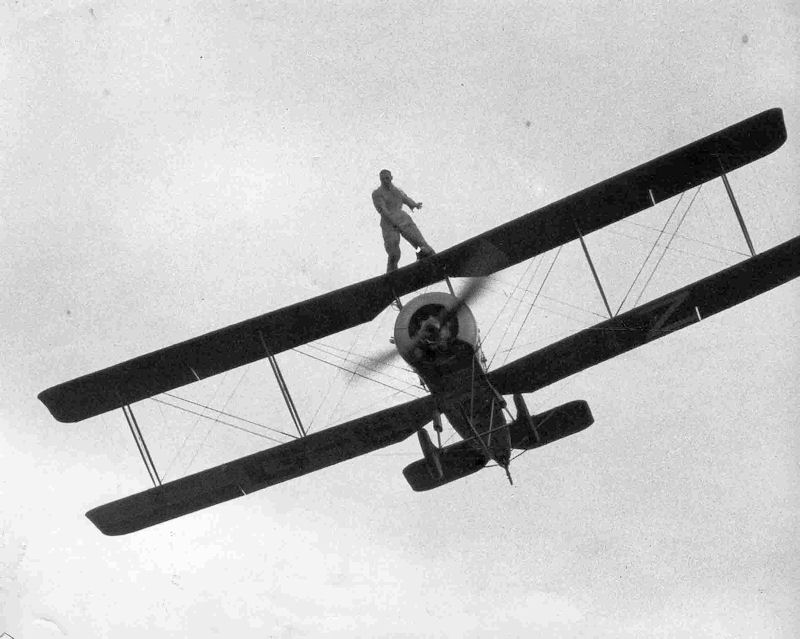
"About 300 displays will be given throughout Britain. The actual programme will be not dissimilar to that to which we have already become accustomed by virtue of the great number of flying meetings there have been during the last two or three years, but there will, in addition, be many items not usually seen."
The approximate programme, subject to changes as required, of course, is as follows:
- FLYPAST - the loud-speaking equipment assisting by explaining the aircraft;
- FORMATION FLIGHT led by the Airspeed "Ferry" with passengers on board;
- AEROBATICS - a "Tiger Moth" being used for this purpose which has been fitted for inverted flying;
- CRAZY FLYING;
- DANCING IN THE AIR - the pilot in this case will endeavour to fly in a "syncopated" fashion to music broadcast from the radio van, his Comper "Swift" being fitted with receiving apparatus;
- TOWED GLIDING;
- An AIR RACE around pylons something on the lines of dirt-track racing;
- PARACHUTE DESCENT;
- INVERTED FLYING in the "Tiger Moth";
- CONTINUOUS ROLLING in the "Martlet";
- A SURPRISE ITEM;
- WIRELESS CONTROL - spectators will be invited to tell the pilot of the Comper "Swift," by means of wireless, what manoeuvre they wish him to do;
- AEROBATICS IN FORMATION;
- And a race between the "Autogiro" and a dirt-track rider"
PULPIT PROTEST AGAINST SUNDAY FLYING Efforts Made Avoid Clash with Services OKEHAMPTON CRITICISM A protest against Sir Alan Cobham's display was voiced in the Okehampton Baptist Church on Sunday and some shop windows displayed posters by the Lord's Day Observance Society exhorting the public to keep holy the Sabbath Day. The town itself very quiet, but the fine weather attracted quite a good crowd at the R.A.F. Aerodrome at Folly Gate, where the Air Circus " was held.
Mr. D. L. Eskell, the General Manager, told our representative in the morning that every effort would be made to avoid interference with divine worship, and with this object in view the arrival of the 'planes from Exeter was delayed until 12.45 p.m. In addition the display was closed down in the evening from 6.30 to 7.45 p.m., but, with the weather conditions being exceptionally good for flying, flights were made up to a later hour than was originally arranged.
The parachute descents, which were cancelled owing to bad weather at Exeter, were performed with great success.
QUITE IMPOSSIBLE. It is quite impossible to cut out Sunday flying altogether," declared Mr. Eskell, "for we should not be able to complete our itinerary otherwise. To close down on Sundays would also mean a loss to the industry, and would result in unemployment among those who are engaged in the displays. All the good we are trying to do for flying would be lost unless we operated seven days a week. We have no wish whatever to disturb the Sabbath, or any way interfere with those who wish to go to church this evening." " IT REMAINS FOR CHURCHES TO ACT." Rev. T. Llewellyn Jones, President the Okehampton Free Church Council, preaching at the Baptist Church, said: " Either the Air Ministry is trifling with a serious situation, Sir Alan Cobham is ignoring both the church and the chapel-going public. The police are not prepared enforce the Sunday Observance Act, as the Northampton police did quite recently, and it remains for the church to take what action they can conjunction with sympathetic civic authorities the .country to save the Lord's Day from further exploitation by mere commercialism and secularisation.' For Christian people it must become a matter of example and earnest prayer."
5 April 1932, Gloucester Citizen: "The C B Cochran of the Air: Sir Alan is taking an aerial circus—complete with all types of machines —into the country this month. His capacity for showmanship was apparent when he described his proposed itinerary, and it was evident that he is completely happy when he is "selling the air" to his countrymen."
(C B Cochran was a well-known theatre manager in the 20s and 30s)
"Twelve or fourteen machines will form the circus, a fresh town will be visited each day, and a continuous programme for "turns," each lasting about fifteen minutes, will be given from 11.30 a.m. until dusk. There will be twenty-five separate items in the repertory, and, during the long summer days, the whole performance may be gone through twice. At night the circus, in this respect at least conforming to ancient tradition, will move on to the next town. It will a strenuous time for all concerned".
Postscript
May 1938: "Cdr. E. B. Fielden, of British Airways, has now flown over 100,000 passengers without so much as bruising the very tenderest of them. A lot of his flying was done in the early joy-ride days, operating from small fields, and when chief pilot to Sir Alan Cobham's circus he once took up 768 people in a day. "
Manager:
- Mr D L Eskell
Pilots:
- Alan Cobham
- C W A Scott (1935)
- Flt Lt C K Turner Hughes (Comper Swift)
- Flt Lt Geoffrey Arthur Virley Tyson (Tiger Moth, Lincock)
- Capt E B 'Safety First' Fielden
- Capt H Lawson (aerobatics, 'crazy flying') killed in Cape Town in 1933
- Mr Martin Hearne (wing walking - to be exact, he "ran along the wings, then finally hung by one hand from a wheel on the undercarriage while the machine looped the loop")
- Ivor D Price (parachutist) (killed in May 1935)
- H Ward (parachutist)
- Flt Lt A H C Rawson
- Capt J D Parkinson
- F/O Curndall
- Mr T Nash
- Flt Lt H C Johnson
- Capt A M Glover
- Mr C W H Bebb (Tiger Moth)
- Capt A N Kingwill
- Capt W. MacKay ("Daredevil Red MacKay")
- Messrs Kemp and Faraday (wing walking)
- C H Bembridge (killed in Sep 1934 in G-EBMM)
- R J Ashley (autogiro)
- George E Collins (gliding in 1935)
-
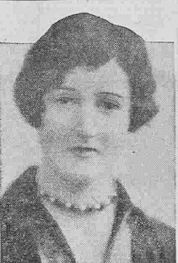 Miss Jean Meakin (1934) (gliding) "Probably the item that held the spectators most enthralled was Miss Joan Meakin's flight in her glider. Towed by an aeroplane and released at a height of 1500 feet, Miss Meakin performed a series of loops before making a perfect landing."
Miss Jean Meakin (1934) (gliding) "Probably the item that held the spectators most enthralled was Miss Joan Meakin's flight in her glider. Towed by an aeroplane and released at a height of 1500 feet, Miss Meakin performed a series of loops before making a perfect landing."Aeroplanes:
- Lincock (in 1933)
- Fox Moth 'that won the Kings Cup Race last year' (ie G-ABUT)
- Tiger Moth
- Gipsy Moth 'that Mr JA Mollison used in his record-breaking Australia-England flight' (ie VH-UFT)
- a 'Klemm monoplane'
- Rhonbussard glider
- 1925 H.P. W.10 G-EBMM which crashed Aston Clinton Bucks Sep 1934;
- 1925 H.P. W.10 G-EBMR which was scrapped Sep 1934;
- 1929 D.H.61 Giant Moth G-AAEV 'The Youth of Britain'
- 1931 Comper CLA.7 Swift G-ABPY;
- 1931 Airspeed AS4 Ferry G-ABSI later sold to CWA Scotts Flying Display Ltd;
- 1931 Airspeed AS4 Ferry G-ABSJ;
- 1932 D.H. Tiger Moth G-ABUL;
- 1932 H.P. 33 Clive I G-ABYX 'The Youth of Australia' which was scrapped in 1933;
- 1932 Avro 621 Tutor G-ABZP;
- 1933 Avro 640 Cadet G-ACLU;
- 1933 Avro 504N G-ACLV;
- 1934 Avro 504N G-ACOD which was destroyed in collision with G-ADFZ over Blackpool in Sep 1935;
- 1934 Avro 504N G-ACOK which crashed Rhyll Aug 1938;
- 1934 Avro 640 Cadet G-ACOZ later sold to CWA Scotts Flying Display Ltd;
- 1934 Avro 640 Cadet G-ACPB later sold to CWA Scotts Flying Display Ltd;
- 1934 Avro 504N G-ACPV;
- 1934 Cierva C.30A G-ACYH;
- 1935 Avro 504N G-ADBD which crashed Southend Jul 1936.
-
-Cobham Displays - 1932
1932
(being) A complete list of Alan Cobham's 'National Aviation Day' displays, in the UK and South Africa, during 1932
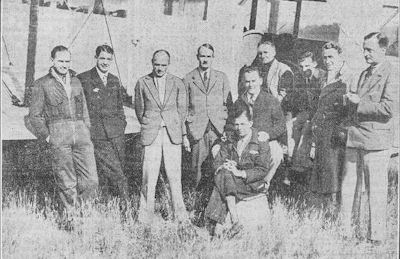

1932 crew in Glasgow: l to r: Flt Lt Rawson, Capt Eskell (manager), Capt Parkinson, F/O Curndall, Capt Lawson, Mr T Nash, Flt Lt Johnson, Mr Martin Hearn, F/O Turner Hughes, Capt Glover Martin Hearne thrills the crowd at Heston, on July 28th Mo Tu We Th Fr Sa Su April 12
- Launch -
Hanworth
13
Luton
14
Ashwell / Royston
(Morden Grange)
15
Bedford
(Cardington)
16
Ilford
(Goodmayes Park)
17
Hanworth
18
Basingstoke
(Old Gof Course)
19
Salisbury
(High Post)
20
Reading
(Woodley)
21
Maidenhead
(Stroud Farm)
22
Aylesbury
23
Walthamstow
(Low Farm)
24
Walthamstow
(Low Farm)
25
Leighton Buzzard
(Billington Rd)
26
Banbury
27
Kidderminster
(Hoo Farm)
28
Worcester
(Derdiswell Park)
29
Abingdon
(Black Horse Barn)
30
Stag Lane
May 1
Stag Lane
2
Swindon
3
Trowbridge
4
Wells
5
Frome
6
Cirencester
7
Gloucester
8
Gloucester
9
Walsall
10
Melton Mowbray
11
Derby
(Stenson Rd)
12
Nottingham
13
Mansfield
14
Rugby
15
Enfield
16
Enfield
17
Romford
18
Chelmsford
19
Colchester
20
Biggin Hill
21
Maidstone
(W Mailing)
22
Maidstone
(W Mailing)
23
Canterbury
(Bekerbourne)
24
Dover
25
Chatham
(Star Farm)
26
Heston, postponed
and replaced by
Ilford
27
High Wycombe
(Marlow Hill)
28
Birmingham
(Northfield)
29
Birmingham
(Northfield)
30
Hereford
(Oldfield)
31
Llandrindod Wells
(Racecourse)
June 1
Cardiff
2
Cardiff
3
Porthcawl
4
Bristol
5
Bath
(Chapel Farm)
6
Bath
(Chapel Farm)
7
Welshpool
(Wernllwyd Farm)
8
Wrexham
(Borras Lodge)
9
Stoke-on-Trent
10
Manchester
11
Liverpool
12
Chester
(Cop House Farm)
13
Stafford
14
Grantham
(Spittlegate Hill)
15
Boston
16
Doncaster
(Armthorpe)
17
Lincoln
(St John's Heath)
18
Bradford
19
Sherburn-in-Elmet
20
Leeds
21
Skipton
22
Ripon
23
Preston
24
Lancaster
25
Lancaster
26
Blackpool
27
Blackpool
28
Whalley
29
Kendal
30
Carlisle
July 1
Alnwick
2
Newcastle
(Cramlington)
3
Newcastle
(Cramlington)
4
W Hartlepool
(Old Seaton)
5
Middlesborough
(Cargo Fleet Lane)
6
Bridlington
(East Leys Farm)
7
Scarborough
(Old Racecourse)
8
Sheffield
(Coast Aston)
9
Sheffield
(Coast Aston)
10
Barnsley
(Old Wombwell)
11
Goole
(Old Racecourse)
12
Skegness
(Aerodrome)
13
Kettering
(Flying Ground)
14
Leicester
(Desford)
15
Leamington Spa
(Flying Field)
16
Bletchley
(Fountain Hotel)
17
Coventry
(Whitley Abbey)
18
Market Harborough
(Cote Hill)
19
Peterborough
(Castor Hill)
20
Hunstanton
(Church Farm)
21
Thetford
(Lodge Farm)
22
Cromer
(Laurel Farm)
23
Norwich
(Mousehold)
24
Gt Yarmouth
(Wheatcroft Farm)
25
Ipswich
26
Clacton-on-Sea27
Mertsham
(Alderstead Farm)
28
Heston
29
Herne Bay
(Parsonage Farm)
30
Deal
(Coldblow Farm)
31
Ramsgate
(Nethercourt)
August 1
Ramsgate
(Nethercourt)
2
Eastbourne
(Frowd's)
3 Eastbourne
(Frowd's)4
Horsham
(North Heath Farm)
5
Reigate
(Rookery Farm)
6
Brighton
(Shoreham)
7 Brighton
(Shoreham)8
Littlehampton
(Ford)
9
Bognor
(Chalcraft Farm)
10
Portsmouth
11
Southampton
12
Bournemouth
(Castle Lane)
13
Bournemouth
(Castle Lane)
14
Weymouth
(Chickerell)
15
Teignmouth
(Little Haldon)
16
Wadebridge
(Three Holes Cross)
17
Camelford
18
Camborne
(Home Farm)
19
Penzance
(Gt Rosevidney Farm)
20
Plymouth
21
Okehampton
22
Bude
(Whalesborough)
23
Ilfracombe
(W Stowland Farm)
24
Taunton
(Musgrove Farm)
25
Weston-super-Mare
(Woodspring Priory)
26
Evesham
(Pershore)
27
Abergavenny
(Racecourse Farm)
28
Swaansea
29
Haverfordwest
30
Aberayron
31
Shrewsbury
September 1
Bangor
2
Rhyl
3
Crewe
4
Warrington
5
St Annes
6
Wigton
7
Dumfries
8
Edinburgh
(Kelso)
9
Peebles
10 Edinburgh
(Silverknowles)
11
Edinburgh
(Silverknowles)
12
Lanark
(Westbank Farm)
13
Alloa
14
Stirling
(Buckhaven)
15
Anstruther
16
Haddington
17
Glasgow
(Moorpark)
18
Glasgow
(Moorpark)
19
Falkirk
(West Mains Farm)
20
St Andrews
(Balgove)
21
Perth
22
Inverness
23
Fraserburgh
24
Aberdeen
25
Dundee
26
Dundee
27
Montrose
28
Arbroath
29
Forfar
(Heatherstacks)
30
Kirkaldy & Buckhaven
October 1
Edinburgh
(Costorphine)
2
Berwick
3
Sunderland
4
Dewsbury
5
Harrogate
6
Hull
7
Bolsover
8
Sheffield
9
Birmingham
10
Wellingborough
11
Cambridge
12
Gravesend
13
Dartford
14
Sheerness
15
Woolwich
16
- Last of UK season -
Chingford
.......
South African Tour: 1 Dec - 18th Feb 1933; about 54 venues.
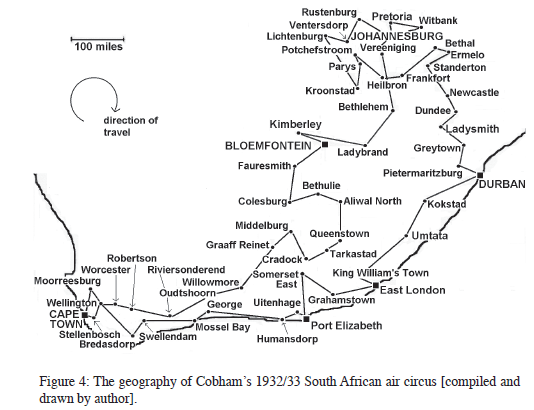
ref: http://www.scielo.org.za/scielo.php?pid=S0259-01902009000100003&script=sci_arttext
December 1
CAPE TOWN
2
CAPE TOWN
3
CAPE TOWN
4
CAPE TOWN
5 6 7 8 9 10 11 12 13 14 15 16 17 18 19 20 21 22 23 24
BLOEMFONTEIN
'in wet, windy weather'
25 26 27 28 29 30 31
"Several of the "Derby Evening Telegraph" readers who enjoyed our free flights have written to the Editor expressing thanks. "I would like to say," writes one reader, "that if anyone is frightened of going up, there is nothing at all of which to be afraid. It is very similar to being in a motor-car. The only difference is when the machine lands and then you catch your breath a bit. But it's a great thrill."
"DESPITE CLERGY'S OPPOSITION Despite opposition from the clergy of Berwick, Sir Alan Cobham's air circus will visit the town on Sunday and give a display. The clergy's protest was to the effect that Sunday was not a suitable day, and that it would affect the attendances at church. The Mayor of Berwick, at the Town Council meeting, said, "I shall be on the flying ground after church. I do not think I shall go myself; I do not want to fly with anybody."
"PLANE CRASHES AT RUFFORD. SIR ALAN'S "CIRCUS" PILOT ESCAPES. BOLSOVER DISPLAY. One of Sir Alan Cobham's air circus planes crashed near Rufford, yesterday, while on its way to take part in an aviation display arranged Sir Alan at Bolsover. The pilot, named Herne, escaped without injury, though the machine capsized. The accident occurred when the plane was taking off after a landing, and the engine and wings were considerably damaged."
Sir Alan Cobham in South Africa
"AIR CIRCUS FOR SOUTH AFRICA When Sir Alan Cobham leaves on November 4 for South Africa upon an organised tour, during which will visit 70 centres with a fleet of aeroplanes, he will carry among his equipment Osram valves, supplied by the General Electric Co., Ltd.
During the tour one of the 'planes will literally dance in the air to broadcast music picked up by the valves"
December 1932: "The outfit is completed by a Public Address apparatus in its own van and a very comprehensive fleet of six-wheeled 2-1/2 ton Leyland lorries and Siddeley saloon cars to deal with all the equipment during the many moves from place to place."
17 Feb 1933: "DARING AIRMAN KILLED IN CRASH AT CAPETOWN. STUNTS IN GLOUCESTER Two airmen belonging to Sir Alan Cobham's air circus have been killed in a crash at Capetown airport. They were Captain H. Lawson and Mr. E. Ross. The two aeroplanes were stunting together over the airport, when one, piloted by Captain Lawson, crashed from a height of 3,000 feet. Captain Lawson was married only eight days ago to Miss Stella Parsons, a 21-years-old girl of Uitenhage. Their romance started when at Maritzburg when he took her up as passenger. Mr. Ross was the wireless expert.
Cool and Accomplished Pilot
Capt. Lawson was with Sir Alan Cobham's National Air Display at Partou Farm, Cheltenham-road, near Gloucester, on May 7 and 8 last year. He gave a most polished and daring exhibition of acrobatics. He flew upside down, executed a loop with the pilot the outside of the loop, one of the most difficult feats that is possible in the air, and slow rolls and turns without banking. He showed Gloucester that he was one of the most daring, cool, and accomplished stunt pilots that aviation has known."
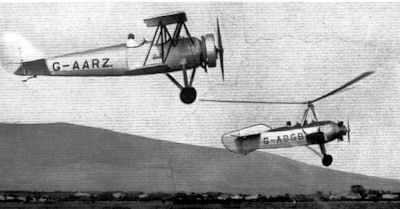
Pilots:
- Sir Alan Cobham
- Fit. Lt. C. F. Turner-Hughes (aerobatics pilot)
- Fit. Lt. H. C. Johnson
- Fit. Lt. H. Lawson
- Fit. Lt. A. H. C. Rawson (Autogiro),
- Mr. C. W. H. Bebb
- Mr. M. Hearn
- Mr Louw (Vacuum Oil Co)
Parachutist:
- Mr. Ivor Price
Aeroplanes:
- 1931 D.H.66 Hercules G-ABMT 'City of Cape Town' (bought from Imperial Airways, Ltd., and used for passenger flights);
- 1930 Cierva C.19 IV Autogiro G-ABGB (demonstrations and passenger flights);
- 1931 Armstrong-Whitworth A.W.16 G-ABKF (aerobatics);
and three Avro Tutors (chiefly for passenger aerobatics and trial lessons):
- 1932 Avro 621 Tutor G-ABZP belonging to National Aviation Displays Ltd;
- 1929 Avro 621 Tutor G-AARZ belonging to Avro;
- 1932 Avro 621 Tutor G-ABZR belonging to Avro
plus
- Avro Avian (Vacuum Oil Co) - presumably 1930 Avro 594 Avian IVm ZS-ABQ
-
-Cobham Displays 1933
1933
A complete list of Alan Cobham's 'National Aviation Day' and the 'British Hospitals Air Pageant' displays, in the UK and South Africa, during 1933.
Cobham: 306 displays. Two tours operated simultaneously in the summer in the UK.
Mo Tu We Th Fr Sa Su
ref: http://www.scielo.org.za/scielo.php?pid=S0259-01902009000100003&script=sci_arttext
January 1
2
3
4
5
6 7
8
9
10
11
12
13
14 15
16
17
18
19
20
21
22
23
24
25
26
27
28 29 30 31 February 1 2 3 4 5 6 7 8 9 10 11 12 13 14 15 16 17 18
CAPE TOWN
- End of S A Tour -
19 March 1 2 3 4 5 6 7 8 9 10 11 12 13 14 15 16 17 18 19 20 21 22 23 24 25 26 27 28 29 30 31 April 1 2 3 4 5 6 7 8
BHAP: Yeading
9
BHAP: Yeading
10
BHAP: Sundridge
11
BHAP: Chatham
12
BHAP: Penshurst
13
BHAP: Watford
14
- Cobham: start of UK season -
- (day off)
&
Southend
15
Dagenham
&
Southend
16
Woolwich
&
Gravesend
BHAP: Kingston
17
Woolwich
&
Maidstone
BHAP: Walthamstow
18
Hitchin
&
Elstree
BHAP: Walthamstow
19
Gatwick
&
Luton
BHAP: Addington
20
Canterbury
&
Hertford
BHAP: Hitchin
21
Tenterden
&
Kings Langley
22
Mertsham
&
W Clandon
BHAP: Harrow
23
Mertsham
&
W Clandon
BHAP: Chingford
24
Wallingford
&
Alton
BHAP: Hanworth
25
Slough
&
Petersfield
26
Welwyn
&
Reigate
BHAP: Hanworth
27
Pangborne
&
Chichester
BHAP: Kettering
28
Epsom
&
Newbury
BHAP: Oxford
29
Warlingham
&
Southampton
BHAP: Guildford
30
Warlingham
&
Christchurch
BHAP: Northampton
May 1
Faringdon
&
Lymington
BHAP: Buckingham
2
Witney
&
Shaftesbury
BHAP: Leamington
3
Uxbridge
&
Salisbury
BHAP: Stratford
4
Colchester
&
Gloucester
BHAP: Shrewsbury
5
Evesham
&
Warminster
BHAP: Ludlow
6
Birmingham
&
Taunton
BHAP: Gloucester
7
Birmingham
&
Taunton
BHAP: Reading
8
Daventry
&
Barnstaple
BHAP: Winchester
9
Banbury
&
Delabole
10
Kidderminster
&
Newlyn East
BHAP: Swindon
11
Burton-on-Trent
&
Hayle
BHAP: Stroud
12
Melton Mowbray
&
St Austell
BHAP: Trowbridge
13
Leamington
&
Exeter
BHAP: High Post
14
lLeamington
&
Okehampton
BHAP: Fareham
15
Towcester
&
Wells
BHAP: Wallingford
16
Rugby
&
Sherborne
BHAP: Colchester
17
High Wycombe
&
Devizes
BHAP: Bishops Stortford
18
Ashford
&
Radstock
BHAP: Cambridge
19
Thakeham
&
Weston-super-Mare
BHAP: Peterborough
20
Bexhill
&
Hereford
BHAP: Coventry
21
Folkestone
&
Hereford
BHAP: Ross-on-Wye
22
Lingfield
&
Melksham
BHAP: Llandindrod Wells
23
Brentwood
&
Chepstow
BHAP: Welshpool
24
St Albans
&
Port Talbot
BHAP: Stafford
25
Oxford
&
Cardigan
26
Finedon
&
- (day off)
BHAP: Pontefract
27
Ipswich
&
Porthcawl
BHAP: York
28
Clacton
&
Cardiff
BHAP: Leeds
29
Braintree
&
Builth Wells
BHAP: Leeds
30
Huntingdon
&
Aberayron
BHAP: Melton Mowbray
31
Boston
&
Welshpool
BHAP: Lincoln
June 1
Cambridge
&
Walsall
2
Lichfield
&
Leominster
BHAP: Stamford
3
Sheffield
&
Bristol
BHAP: Stoke-on-Trent
4
Nottingham
&
Bristol
BHAP: Stoke-on-Trent
5
Sheffield
&
Derby
BHAP: Swansea
6
Newark
&
Stone
BHAP: Swansea
7
Lincoln
&
Malvern
BHAP: Yeovil
8
Doncaster
&
Shrewsbury
BHAP: Teignmouth
9
Bawtry
&
Bridgenorth
BHAP: Tiverton
10
Woodford
&
Solihull
BHAP: Birmingham
11
Leeds
&
Solihull
BHAP: Birmingham
12
Leeds
&
Tamworth
13
Wrexham
&
St Neots
14
Chester
&
Wisbech
BHAP: High Wycombe
15
Oswestry
&
Gt Dunmow
BHAP: Worcester
16
Rhos Ucha
&
Newport Pagnell
BHAP: Haverford West
17
Birkenhead
&
Brighton
BHAP: Haverford West
18
Birkenhead
&
Brighton
BHAP: Hereford
19
Knutsford
&
Sudbury
BHAP: Frome
20
Blackpool
&
Long Eaton
BHAP: Camelford
21
Lancaster
&
Sleaford
BHAP: Plymouth
22
Kendal
&
Retford
BHAP: St Austell
23
Whitehaven
&
Scunthorpe
BHAP: Truro
24
Workington
&
Hull
BHAP: Minehead
25
Workington
&
Hull
BHAP: Cirencester
26
Wigton
&
Barton
BHAP: Sherborne
27
Annan
&
Leek
BHAP: Bude
28
Castle Douglas
&
Redcar
BHAP: Tavistock
29
Stranraer
&
W Hartlepool
BHAP: Taunton
30
- (transit)
&
Chester-le-Street
BHAP: Taunton
July 1
Dublin
&
Newcastle-on-Tyne
BHAP: Bideford
2
Dublin
&
Newcastle-on-Tyne
BHAP: Bideford
3
Waterford
&
Kelso
BHAP: Blandford
4
Clonmel
&
Penicuik
BHAP: Clevedon
5
Cork
&
Perth
BHAP: Devizes
6
Cork
&
Kirkintilloch
BHAP: Weston Super Mare
7
Limerick
&
Alloa
BHAP: Dorchester
8
Limerick
&
Glasgow
BHAP: Portsmouth
9
Dublin
&
Glasgow
BHAP: Bognor
10
Galway
&
Bathgate
11
Bundoran
&
St Andrews
12
Londonderry
&
Brechin
BHAP: Bournemouth
13
Londonderry
&
Kirriemuir
14
Belfast
&
Huntly
BHAP: Ford
15
Belfast
&
Macduff
BHAP: Shoreham
16
Dundalk
&
Aberdeen
BHAP: Shoreham
17
- (travel)
&
Aberdeen
BHAP: Reigate
18
Harwick
&
Lossiemouth
BHAP: Wye
19
Lockerbie
&
Nairn
BHAP: Eastbourne
20
Carlisle
&
Stonehaven
BHAP: Chichester
21
Penrith
&
Bathgate
BHAP: Bekesbourne
22
Barrow-in-Furness
&
Edinburgh
BHAP: Whitstable
23
Aintree
&
Edinburgh
BHAP: Dagenham
24
Heywood
&
Dunbar
BHAP: Clacton
25
Bury
&
N Berwick
BHAP: Bury St Edmunds
26
Unsworth
&
Airdrie
BHAP: Southend
27
Stoke-on-Trent
&
Berwick-on-Tweed
BHAP: Southend
28
Altrincham
&
Morpeth
29
Redditch
&
Tynemouth
30
Wolverhampton
&
Tynemouth
BHAP: Yarmouth
31
Nuneaton
&
Sunderland
BHAP: Felixstowe
August 1
Loughborough
&
Richmond (Yorks)
BHAP: Thetford
2
Gt Barr
&
Darlington
BHAP: King's Lynn
3
Burton-on-Trent
&
Stockton-on-Tees
BHAP: Spalding
4
Stratford-on-Avon
&
Bridlington
BHAP: Long Eaton
5
Stag Lane
&
Yeadon
BHAP: Derby
6
Stag Lane
&
Blackburn
BHAP:
Liverpool
7
Stag Lane
&
Blackburn
BHAP: Speke
8
Herne Bay
&
Blackpool
BHAP: Southport
9
Margate
&
Bolton
BHAP: Lancaster
10
Folkestone/Dover
&
Thirsk
BHAP: Carlisle
11
Folkestone/Dover
&
York
BHAP: Houghton le Spring
12
Lewes
&
Birkenhead
BHAP: Newcastle
13
Brighton
&
Birkenhead
BHAP: Sherburn
14
Eastbourne
&
Bakewell
BHAP: Northallerton
15
Littlehampton
&
Skegness - 'showers and high winds'
BHAP: Stockport
16
Burgess Hill
&
Cromer
BHAP: Nuneaton
17
Ryde
&
Cromer
BHAP: Newark
18
Shanklin
&
Lowestoft
BHAP: Rugby
19
Portsmouth
&
Norwich
BHAP: Walsall
20
Wimborne
&
Yarmouth
BHAP: Birmingham
21
Petworth
&
Frinton
BHAP: Leominster
22
Bournemouth
&
Southend
BHAP: Banbury
23
Weymouth
&
Ramsgate
BHAP: Kidderminster
24
Swanage
&
Birchington
BHAP: Scunthorpe
25
Teignmouth
&
Bexhill
BHAP: Stretford
26
Plymouth
&
Eastbourne
BHAP: Sheffield
27
Newquay
&
Bognor
BHAP: Harrogate
28
Newquay
&
Bridport
BHAP: Redcar
29
Camborne
&
Exeter
BHAP: West Hartlepool
30
Penzance
&
Budleigh Salterton/Exmouth
BHAP: Eaton
31
Bodmin
&
Lyme Regis
BHAP: Stockton
September 1
Bude
&
Launceston
BHAP: Castle Douglas
2
Barnstaple
&
Padstow
BHAP: Ayr
3
Wellington
&
Fowey
BHAP: Dundee
4
Ilfracombe
&
Chard
BHAP: Arbroath
5
Ilfracombe
&
Minehead
BHAP: Banff
6
Bridgewater
&
Cheltenham
BHAP: Aberdeen
7
Nailsworth
&
Ammanford
BHAP: Huntly
8
Hay
&
Tenby
BHAP: Stonehaven
9
Whitchurch
&
Swansea
BHAP: St Andrews
10
Beaumaris
&
Abergavenny
BHAP: Renfrew
11
- (travel)
&
Pwllheli
BHAP: Falkirk
12
Carlow
&
Rhyl
13
Wexford
&
Whalley
14
Dungarvon
&
Preston
15
Fermoy
&
Widnes
BHAP: Jedburgh
16
Athy
&
Sheffield
BHAP: Peebles
17
Portmarnock
&
Barnsley
BHAP: Dunbar
18
Boyle
&
Hull
(Driffield)
BHAP: Edinburgh
19
Bundoran
&
Gainsborough
BHAP: Tynemouth
20
Sligo
&
Mansfield
21
Castlebar
&
Grimsby
BHAP: Bishops Aukland
22
Ballinrobe
&
Peterborough
BHAP: Darlington
23
Nenagh
&
E Dereham
BHAP: Yeadon
24
Killarney
&
Hunstanton
25
Tralee
&
N Walsham
BHAP: Doncaster
26
Newwcastle W
&
Ely
27
Mallow
&
Bungay
28
Cahir
&
Saffron Walden
BHAP: Hinckley
29
Tullamore
&
Bletchley
BHAP: Wolverton
30
Athlone
&
Kingston
BHAP: Slough
October 1
Drogheda
&
Harrow
BHAP: Abridge
2
- (travel)
&
Uckfield
3
Caernarvon
&
E Grinstead
4
Presteign
&
Chippenham
5
Worcester
&
Aldborne
6
Chipping Norton
&
Horsham
BHAP: Woking
7
Molesey
&
Dartford
BHAP: Reading
8
Staines
&
Romford
Cobham: End of UK Season -
BHAP: Woolwich
15
16 17 18
BHAP: Hook
AIR CIRCUS'S 700,000 MILES. SIR ALAN COBHAM'S PLANS FOR NEXT YEAR. Taunton people who remember the visit of Sir Alan Cobham's air circus this year will be glad to hear that it is likely to return next season. Sir Alan is now at work on a programme including still more exciting aerobatics" which he hopes to make a feature of the displays. The pilots and machines are now in their winter quarters after having given displays during 1933 at 306 towns in Great Britain and Ireland. The 18 machines which comprised the two squadrons flew a total distance of 700,000 miles, consuming 124,000 gallons of National benzole. Over 800,000 people paid for admission to the displays, and enjoyed aerial trips. In most cases it was their first flying experience. The road transport section of the circus necessitated the use of 36 vehicles, which covered more than 9,500 miles on each of the two tours.
Gloucestershire Echo "TEN MACHINES TAKE PART The display was a big improvement on last year's show. No fewer than 10 machines took part, the aerobatics and exhibitions were more daring and comprehensive, the general arrangements were better, and there was greater variety of flying. The whole from the most intricate exhibition to the efficient car parking arrangements, ran smoothly and punctually. The attendance was as big as ever, which seems to indicate that Sir Alan's aim to make everyone air-minded is being fulfilled in this district least.
Large numbers booked flights with great eagerness, with the result that machines were constantly going up and down giving passenger flights. In the lighter and faster 'planes longish trips with half rolls cost 7s. 6d. a passenger, and all the stunts imaginable could be obtained for 15s.
Though to many the novelty of flying must have worn off, as soon as Captain Eskell, who superintended the display with his usual proficiency, announced a particularly attractive item there was a rush for the booking tent.
CRAZY FLYING For the amusement of those who prefer to be air-minded from a terrestrial standpoint—with their feet firmly planted on the ground and neck craned skywards—there was a certain Capt. Mackay, among others. This wizard of the air likes nothing better than flying in and out of trees, people's heads and other things close to the ground. His impersonation of a pilot who had forgotten quite a lot about aeroplanes was probably the best aerial entertainment seen in Gloucestershire. After darting hither and thither with the skill and sureness of a dragon-fly, Capt. Mackay reached a thrilling climax by streaking over the heads of the crowd, standing in his cockpit and waving his arms all directions.
Capt. Jacques demonstrated the autogiro, which with its weird mechanism is capable of such wonderful feats.
Mr C. W. H. Bebb, flying Tiger Moth, gave a fine display of aerobatics, in which he flew upside down for an unusually long he righted the 'plane with a skilful inverted turn.
Kemp and Mr. Faraday gave exhibition of simultaneous wing walking the wings of the same plane. The crowd cheered its admiration of their daring.
There were hosts of other interesting items, such as speed-judging competitions, height-judging, shooting st balloons from the air, pylon racing, and the grand formation flight."
"In connection with the National Aviation Day Crusade, Sir Alan Cobham will be coming on Monday next, May 8th, to Barnstaple personally to conduct and fly in his air display, which is to be held at Heanton Court. With the support of the entire aeronautical community, Sir Alan has arranged to hold the National Aviation Day Display at over 300 towns throughout the British Isles this summer, and once again Sir Alan is bringing before the public the finest air pageant yet seen. At each display Sir Alan will show the public what British aviation is doing by the most effective means possible —by a brilliant display of flying, which will depict in a popular manner all that is finest in aircraft and piloting skill.
Sir Alan's squadron is composed of such distinguished pilots as Flying Officer C. K. Turner Hughes and Mr. C. W. H. Bebb, masters of the art of aerobatics, Flight Lieut. A. H. C. Rawson, the famous pioneer test pilot of the Autogiro, Flight Lieut. H. C. Johnson, and Capt. J. D. Parkinson, well-known as pilots of Sir Alan's Handley Page and airspeed air liners, Messrs. Ivor Price and H. Ward, the leading British parachutists, Mr. Martin Hearn, most fearless of wing-walkers, and the two redoubtable exponents of crazy flying, Capt. A. N. Kingwill, and Mr. W. MacKay ("Daredevil Red MacKay.")
Sir Alan has assembled the greatest gathering of air talent yet brought together in one organisation, for he is determined to stir everyone to give enthusiastic support to the cause of British aviation. "
"For the 1933 display season, Sir Alan Cobham’s rival, the British Hospitals Air Pageant (BHAP), had obtained the use of Cornwall Aviation Company’s aircraft, which were normally used by Sir Alan Cobham, leaving Cobham requiring replacement aircraft. This short fall was made up from the bankrupt stock of Northern Air Transport supplied through Lance Rimmer’s association with the company. Thus surplus military Avro 504Ks G-ABLL (ex.J8333), G-AHBJ (ex. J8343) and G-AHBK (ex. J8351) appeared with the No.2 team after August 1933.
Rimmer also put the Avro 504Ns of his own company,North British Aviation, at Cobham’s disposal for the duration of this short fall. G-AHBJ & G-AHBK were written off later in the year after crashing at Hooton Park, halving the fleet of Northern Air Transport."
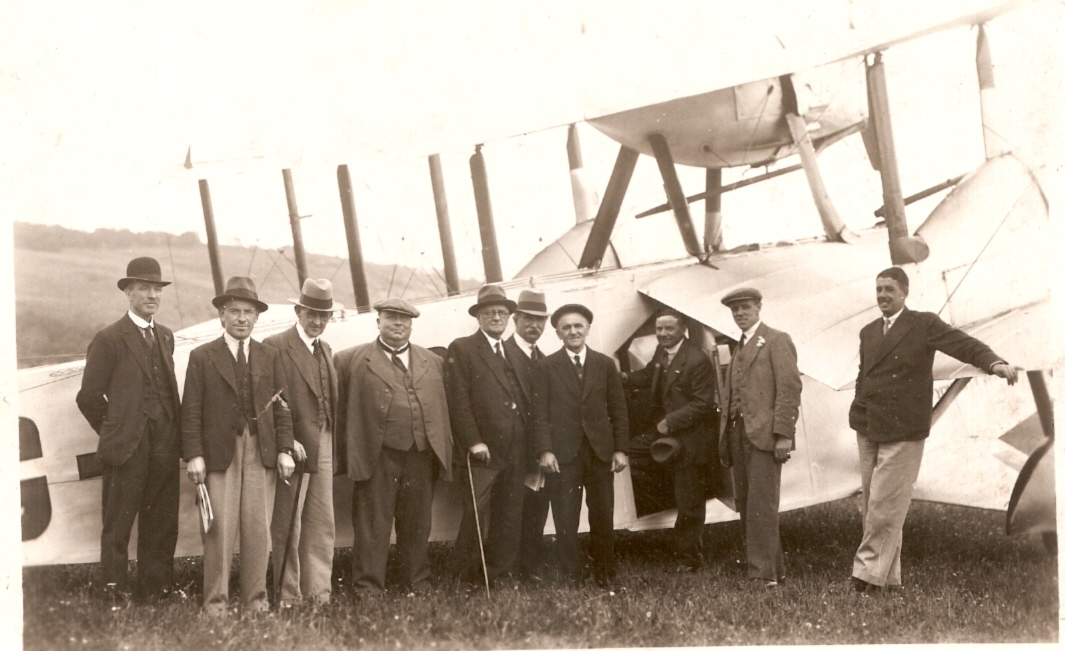
These august members of the Builth Wells Council were taken up aloft in the Airspeed Ferry by pilot E.B ('Safety First') Fielden (q.v.)
(photo courtesy Phillip Jones)
"TWO BOYS KILLED AT AIR CIRCUS. Two boys were killed last night when they were struck by an aeroplane belonging to Sir Alan Cobham's circus in Middleton Park, Leeds, where an aerial display was being given. The boys were Frederick Smith, 12, of Cameron street, Stoneyrock lane, Leeds ; and Leslie Taylor, 8, Westbury-street, Leeds. Sir Alan Cobham was greatly distressed. It is terrible," he said. There was no defect in the machine, and neither the pilot, Mr. Johnson, nor any of his 21 passengers knew that anything had happened until they were told afterwards. The two boys were struck by the tail of the plane. I cannot account for the accident unless the machine was caught by a sudden down current or gust of air. The machine was landing in the ordinary course, and the boys were on the edge of the aerodrome. They were not in the reserved enclosure. Mr. Johnson is a most experienced pilot. This is the first serious mishap we have had at one of the displays. Nearly 1,000,000 spectators have witnessed them in various parts of the country, and about 250,000 passengers have been in the machines. We have given about 800 displays."
Alan Cobham: "At Limerick in 1933 Geoffrey Tyson was flying the Fox Moth with four passengers on board, and suddenly found himself without an undercarriage, so that he had to make a belly landing. He did this most delicately in soft grass, and his passengers were unhurt and even unaware that anything unusual was happening. It wasn't his fault; a local Irish pilot had insisted on joining in with the display aircraft without bothering to learn the necessary discipline, and had flown beneath Geoffrey's aircraft and wiped off the undercarriage. He and his passenger were both killed."
-
-Cobham Displays 1934
1934
A complete list of Alan Cobham's 'National Aviation Day' displays in 1934
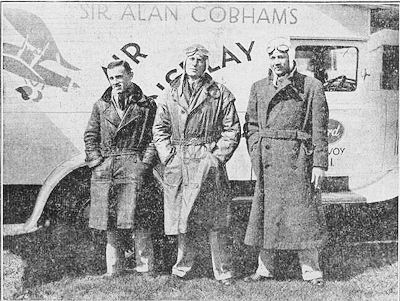
l to r: Martin Hearn, Flt-Lt Geoffrey Tyson, and Mr Johnstone (sic)
GROUP CAPTAIN "JOHNNIE" JOHNSTON, who died in 2002 aged 83, was seized with an ambition to follow his father as a pilot and specialist navigator after hearing of his death as navigator of the ill-fated airship R 101.
Johnston, as he liked to reminisce, was "born with both ears cocked for the sound of aero engines" and brought up in the airship and aviation community. His first memories of aeroplanes dated from Croydon aerodrome in 1924, when he spent his time scrambling about in Handley Page W 8 biplane airliners and the eight-passenger DH 34s which served on the London to Paris route.
His father had joined Daimler Airways as navigation officer shortly before Daimler was absorbed into Imperial Airways. Aged six, Johnston climbed the ladder to reach the cockpit, where he would daydream for hours.
"The DH 34 was the biggest influence in making concrete my intention to become an aeroplane pilot," he recalled. Later he transferred his affections to the DH 61 of Sir Alan Cobbam's flying circus, known as the "Giant Moth", which was to stir the ambitions of a generation of boys who became Second World War aircrew.
Shortly afterwards, however, Johnston's enthusiasm switched to airships, following his father's appointment as navigation special assistant in the newly-created Directorate of Airship Development.
Mo Tu We Th Fr Sa Su April 9 10 11 12 13 14
Dagenham
15
Guildford
16
Alton
17
Devizes
18
Weston-super-Mare
19
Bath
20
Malvern
21
Leamington Spa
22
Birmingham
23
Leek
24
Lymm
25
Bolton
26
Cockermouth
27
Whitehaven
28
Carlisle
29
Barrow-in-Furness
30
Penrith
May 1
Dumfries
2
Kelso
3
Lanark
4
Kirkintilloch
5
Cambuslang
6
Edinburgh
7
Dundee
8
Dundee
9
Macduff
10
Peterhead
11
Huntly
12
Aberdeen
13
Aberdeen
14
Inverness
15
Thurso
16
Wick (Westerseat)
17
Tain
(Morangie)
18
Lossiemouth & Elgin
19
Berwick-on-Tweed
20
Tynemouth
21
Tynemouth
22
Chester-le-Street
23
Darlington
24
Sheffield
25
Knottingley
26
Doncaster
27
Sunderland
28
Scarborough
29
Louth
30
Retford
31
Scunthorpe
June 1
Market Weighton
2
Brighouse
3
Brighouse
4
Redcar
5
Richmond (Yorkshire)
6
Derby
7
Stoke-on-Trent
8
Walsall
9
Birmingham
10
Birmingham
11
Bedford
12
High Wycombe
13
Reading
14
Chesham
15
Sherborne
16
Bristol
17
Birmingham
18
Rugby
19
Worcester
20
Kidderminster
21
Nottingham
(Tollerton)
22
Southport
23
Woodford
24
Leamington Spa
25
Ramsey
26
Colchester
27
Penshurst
28
Swalecliffe
29
Petersfield
30
Farnborough
July 1
Gravesend
2
Uckfield
3
Thakeham
4
Southampton
5
Havant
6
Whitchurch
7
Bournemouth
8
Ryde
9
Shanklin
10
Wimborne
11
Blandford
12
Newbury
13
Trowbridge
14
Bristol
15
Wolverhampton
16
Aberystwyth
17
Aberystwyth
18
Pwllheli
19
-
20
Birkenhead
21
Liverpool
22
Aintree
23
Blackpool
24
Bury
25
Bolton
26
Blackburn
27
Unsworth
28
Manchester
29
Manchester
30
Pershore
31
Lynton
August 1
Barnstaple
2
Newquay
3
Penzance
4
Mullion
5
Padstow
6
Falmouth
7
St Austell
8
Exeter
9
Exmouth
10
Lyme Regis
11
Teignmouth
12
Taunton
13
Crewkerne
14
Swanage
15
Littlehampton
16
Winchester
17
Bognor
18
Shoreham
19
Shoreham
20
Hastings
21
Hastings
22
Tunbridge Wells
23
Bexhill
24
Folkestone
25
Rochester
26
Birchington
27
Sheppey
28
Southend
29
Frinton
30
Gt Yarmouth
31
Cromer
September 1
Hunstanton
2
Wakefield
3
Hull
4
Saltburn
5
Stockton-on-Tees
6
Stockton-on-Tees
7
W Hartlepool
8
Newcastle-on-Tyne
9
Gateshead
10
Leeds
11
Ely
12
Sutton (Cambs)
13
Sutton (Cambs)
14
Northampton
15
Tunstall
16
Tunstall
17
Lincoln
18
Sutton-on-Sea (Lincs)
19
Burton-on-Trent
20
Leicester
21
Kettering
22
Coventry
23
Slough
24
Hereford
25
Cardiff
26
Barry
27
Port Talbot
28
Chepstow
29
Staines
30
Romford
- End of season -
"TICKETS TO BE RETURNED Sunday Flying Protest DECISION AT PADSTOW Council And Aerial Circus STRONG disapproval of Sir Alan Cobham's proposed visit to Padstow on Sunday next with his flying circus to give a display at Porthmissen Farm was expressed at a meeting of Padstow Urban Council on Tuesday evening, when Mr. N. Parkin presided. The Clerk (Mr. F. A. Williams) announced that Sir Alan had sent the Council a number of tickets for free flights in one of his air liners on Sunday. The Chairman: Take my ticket and send it back to him, and tell him as far as I am concerned I am very much opposed to Sunday flying or anything of that sort."
"MAN WHO FLEW THE CHANNEL UPSIDE DOWN. HE IS COMING TO HULL AIR CIRCUS Hull shortly to see the pilot who recently celebrated the anniversary of Bleriot's pioneer Channel flight by doing the same flight— upside-down. He is Flight-Lieutenant Geoffrey Tyson, who is coming to Hull as principal display pilot in Sir Alan Cobham's flying circus."
Alan Cobham: "My pilots could make mistakes, sometimes fatally. In 1934 one of our stunt pilots, Jock Mackay, was amusing the crowd with the 'crazy flying routine', in which some very experienced pilot would put on unsuitable clothes and climb aboard an aircraft and take it off, while we all cried 'stop that man!' as though he were really an unqualified member of the public. The performance that followed - of wildly erratic flying very close to the ground, with the supposedly incompetent pilot climbing out onto the wing and back again and buffooning in every way - was very amusing to those who had tumbled to the trick, if frightening to those that hadn't, and it was a regular part of our show. But on this occasion Jock seems to have got the stick tangled up with his leg and the throttle, and he hit the ground before he could release it; he died that night in hospital."
-
-Cobham Displays 1935
1935
A complete list of Alan Cobham's 'National Aviation Day' displays for 1935

At Aberdeen: Another one of them there composite photographs
Mo Tu We Th Fr Sa Su April 12
Fareham
13
Redhill
14
Harrow
15
Andover
16
Witney
17
Cirencester
18
Malvern
19
Birmingham
20
Birmingham
21
Dudley
22
Dudley
23
Runcorn
24
Standish
25
Blackburn
26
Northwich
27
St Helens
28
St Helens
29
Chorley
30
Sandbach
May 1
Birkenhead
2
Pwllheli
3
Carlow
4
Enniscorthy
5
Dundalk
6
Belfast
7
Belfast
8
Coleraine
9
Londonderry
10
Sligo
11
Dublin
12
Dublin
13
Maryborough
14
Wexford
15
Kilkenny
16
Waterford
17
Limerick
18
Cork
19
Cork
20
Tralee
21
Calway
22
Castlebar
23
Athlone
24
Longford
25
Liverpool
26
Birkenhead
27
Blackpool
28
29
Leeds
30
Woodford
31
Retford
June 1
Brighouse
2
Brighouse
3
Doncaster
4
Coventry
5
Derby
(Stenson Rd)
6
Wolverhampton
7
Tewkesbury
8
Leamington Spa
9
Birmingham
10
Birmingham
11
Weston-super-Mare
12
Yeovil
13
Bath
14
Maidenhead
15
Southampton
16
Rochester
17
Thame
18
Oxford
19
Henley-on-Thames
20
Cambridge
21
Chesham
22
Ipswich
23
Romford
24
Havant
25
Fordingbridge
26
Salisbury
27
Lower Kingswood
28
Alton
29 30
Gravesend
July The tour then split into two - the 'Astra' and 'Ferry' shows... 1
Penshurst
and
Huntingdon
2
Sittingbourne
and
Stamford
3
Maidstone
and
Selby
4
Uckfield
and
Northallerton
5
Thakeham
and
Chester-le-Street
6
Bournemouth
and
Durham
7
Eastbourne
and
Durham
8
Maldon
and
Dumfries
9
Walton-on-the-Naze
and
Castle Douglas
10
Felixstowe
and
Cambuslang
11
Southwold
and
Hamilton
12
Cromer
and
Crieff
13
Norwich
and
Kirkcaldy
14
Gt Yarmouth
and
Kirkcaldy
15
Holbeach
and
Inverness
16
Bourne
and
Dingwall
17
Swadlincote
and
Wick
18
Sutton-on-Sea
and
Thurso
19
Scunthorpe
and
Lossiemouth
20
Wakefield
and
Macduff
21
Brighouse
and
Kintore
22
Hull
and
St Andrews
23
Whitby
and
Kilmarnock
24
Saltburn
and
Edinburgh
25
Gateshead
and
Peebles
26
Newcastle-on-Tyne
and
Kelso
27
Newcastle-on-Tyne
(joint display)
28
Nottingham
and
Sunderland
29
Hunstanton
and
Carlisle
30
Ramsey (Hunts)
and
Cockermouth
31
High Wycombe
and
Wigton
August 1
Ramsgate
and
Penrith
2
Birchington
and
Workington
3
Swalecliffe
and
Barrow
4
Folkestone
and
Middleton
5
Hastings
and
Reddish
6
Hastings
and
Llandudno
7
Bexhill
and
Llandudno
8
Worthing
and
Aberystwyth
9
Bognor
and
Llanelly
10
Christchurch
and
Pontypool
11
Cowes
and
Pontypool
12
Yarmouth IOW
and
Cheltenham
13
Shanklin
and
Wantage
14
Bembridge
and
Glastonbury
15
Swanage
and
Gillingham (Dorset)
16
Weymouth
and
Crewkerne
17
Teignmouth
and
Bristol
18
Newton Abbot
and
Cricklade
19
Lyme Regis
and
Taunton
20
Exmouth
and
Woolacombe
21
Barnstaple
and
Tavistock
22
Launceston
and
Falmouth
23
Liskeard
and
Salcombe
24
Plymouth
and
Sidmouth
25
Newquay
and
Guildford
26
Penzance
and
Pitsea
27
Torrington
and
Sheerness
28
Minehead
and
Hythe
29
Lynton
and
Rye
30
Dulverton
and
Seaford
31
Wimborne
and
Sanderstead
September 1
Gosport
and
Sanderstead
2
Littlehampton
and
Rickmansworth
3
Selsey
and
Wisbech
4
Kingston
and
Horncastle
5
Staines
and
Sutton Coldfield
6
Shifnal
and
Lytham
7
Wigan (Standish)
and
Blackpool
8
Wigan (Standish)
and
Cannock
9
Southport
and
Bakewell
10
Lowton
and
Ormskirk
11
Aintree
and
Altrincham
12
Sheffield
and
Llangefni
13
Coalville
and
Tunstall
14
Solihull
and
Leeds
15 Solihull
and
Leeds16
Nuneaton
and
Long Eaton
17
Towcester
and
Boston
18
Kidderminster
and
Mansfield
19
Burton-on-Trent
and
Grimsby
20
Walsall
and
Tadcaster
21
Northampton
and
Preston
22
Wolverhampton
and
Bury
23
Rugby
and
Welshpool
24
Slough
and
Pershore
25
Sutton (Surrey)
and
Cardiff
26
Ilford
and
Swansea
27
Windsor
and
Chepstow
28
Farnborough
and
Marlborough
29
Dorking
and
Tonbridge
30 Read More...
The Aeroplane: "At Redhill Aerodrome, Kingsmill, Sir Alan Cobham's 1935 National Aviation Day Tour had its opening display on April 13. All events are the best of the kind to be seen, all are done where you can see them, and several are not to be seen except in the Cobham Display.
From the time the display starts until it ends there is always something happening worth watching... our old friend the Airspeed Ferry, or the built-up-areaplane as it has been called, did not appear...
'Miss Joan Meakin's new glider, specially designed for towing by aeroplane with a single wheel and a brake, made its first appearance and behaved very nicely. A specially made radio transmitter is to be fitted... when it is working Miss Meakin will explain each manoevre before doing it and so refute any leg-pulling assertions that the last loop was a fluke."
"Sir Alan Cobham's circus, which will be in Ireland from May 4 until May 23, is co-operating with the Irish Aero Club. Sir Alan's team is also to give a display at Leopardstown, County Dublin"
 1934
1934"Parachutist Falls to Death. Before the eyes of his bride of a fortnight and a crowd of several hundred people, Ivor Price, the famous parachutist, crashed to his death when his parachute failed to open nearly 1000 feet up at the close of a display by Sir Alan Cobham's air circus at Woodford Aerodrome, near Stockport, last night.
Mr Price and Miss Naomi Heron-Maxwell ascended in two Avro Cadet planes, which circled the aerodrome prior to the descent being made. It was to be a dual parachute descent.
Miss Heron-Maxwell rushed to the spot where Price lay, as did officials of the display, but the crowd seemed to stand rooted to the spot. Price, who had made several descents before during the day, some from 1200 feet, was married only a fortnight ago. His wife, who witnessed his death, was overcome. Tugging at Mr R. J. Beard, owner of the Woodford Garage, which backs onto the aerodrome, told a Press representative: " We had a clear view from the garage of the whole display only a few fields away. " Suddenly I realised that while the woman was floating down under an open parachute the other figure was just dropping, the unopened parcel of cloth trailing above his head. "As we strained our eyes we could see the man's hand tugging at something, apparently the ring of the release cord. He disappeared. There was silence. "Then we could hear a man's voice, apparently making appeal through the loud-speaker which had been used to announce all the events." After the fall the announcer of the display shouted through the loud-speaker appeal to the crowd to keep calm and leave the ground in an orderly fashion. Members of the Cobham circus said that the parachute whose failure to open caused Price to crash his death was one that had been selected and then rejected by Miss Heron-Maxwell. One of them said:-"She picked up the parachute from a number of silk chutes which were on the field ready for the parachute jumpers and was about to have it strapped on when she changed her mind, put it down, and picked another one up."
Alan Cobham's version was as follows: "Then there was the extraordinary lapse of Ivor Price, who had been our parachutist from the start and used to pack his own parachutes, using a tied handkerchief to hold the shroud lines in position while he folded the 'chute itself. He was always most careful to remove the handkerchief before finishing the job, but at Woodford in Cheshire, in 1935, he forgot to do so - perhaps because he was distracted by the crowds who always stood around to watch the operation. He did his usual delayed drop, the parachute failed to open, and he was killed at once."
FAMOUS GLIDER : : PILOT KILLED WIFE AND PARENTS SEE CRASH WING SNAPS OFF AT AIR CIRCUS Mr G. E. Collins, Britain's foremost glider pilot, was killed near Ramsey (Hunts) yesterday before the eyes of his wife, father, and mother. They were watching him for the first time in a glider exhibition in connection with Sir Alan Cobham s flying circus. A wing of the glider snapped, and the machine hurtled to earth.
LOUD SNAP. The machine had been towed by aeroplane to a height of more than 2000 feet. Mr Collins had cast off from the tow rope and had made several large circles over Upwood Aerodrome disused military aerodrome—when there was a loud snap and the left wing of the glider broke away from the fuselage. The glider went into a spin. After falling several hundred feet Mr Collins appeared to regain control and began a straight dive. Eye-witnesses state that hung out of the fuselage on the side of the broken wing in an attempt to keep it on an even keeli. The dive, however, continued straight to the ground, and the glider crashed into hedge on the far side of the aerodrome, Mr Collins being killed instantly.
WIFE STUNNED. All the while his parents, sitting in motor car not far from the hangars, had anxiously watched his fall. Mrs Collins, his wife, is stunned by the tragedy. Mr G. W. Jones, of Ramsey, who was playing in a cricket match about two miles from the accident, told a reporter that heard the snar of a broken wing. 'We had stopped play to watch the exhibition, he said. ' The glider had been released from the tow rope two or three minutes before the accident happened." The pilot appeared to put his machine through a loop. Immediately afterwards there was a crack as loud as a gun. The wing left the fuselage and pieces of fabric floated in the air. . " Some parts of the wing were found over a mile from where the glider crashed. There was quite strong wind blowing at the time.
DEAD IN COCKPIT. Mr J. T. Hemmington. of Ramsey, said "Suddenly there was loud snap. A wing came off, and the glider dived into the ground. I ran to the place where it fell and saw the pilot in the cockpit. He was dead." Mr Collins had made many flights in gliders of German construction. It is stated that this was the first time he had flown a British one. Air Ministry inspectors will inspect the wreckage to-day, when the inquest will be held at Ramsey."
Alan Cobham said: "Then there was Collins, who did very fine exhibition flying in a glider but rashly attempted a bunt or inverted loop, though his machine was not stressed for this manoevre; it broke up in the air and killed him."
"THREE DEAD IN BLACKPOOL CRASH Blazing Plane Falls in Crowded Street Thousands of holiday-makers at Blackpool yesterday were horrified witnesses of a mid-air 'plane collision and crash, in which a pilot of Sir Alan Cobham's air circus and two women were killed. The dead pilot was Captain Robert William Patrick Stewart, of Hurlingham. The two women were sisters, Lilian and Doris Barnes, of Gloucester Avenue, Blackpool. They had gone up for a joy ride. Cobham's Air Circus 'planes were flying over the centre of the town, when a large 'plane came into contact with a smaller one. The latter broke in two. The forepart fell in Swainton Street. Before it burst into flames the dead pilot was pulled clear. Later a woman's body was found in the burned-out wreckage."
Alan Cobham remembered this incident in his 1978 autobiography: "Finally, just before we closed down for good on 30 September 1935, we suffered the appalling tragedy of a mid-air collision over Blackpool. A pilot named Carruthers was waiting for the others to join him so that our arrival could be announced by the usual formation flight, when he suddenly felt a violent impact from below... Carruthers managed to land his aircraft in one piece withour hurting anybody, but the pilot of the machine that had flown into him from below - Stewart by name - was killed, as were his two girl passengers and the blind man on whose house they fell. It was a terrible thing."
October 1935
AIRMAN DIES AFTER CRASH. COMPANIONS STILL IN HOSPITAL: CAR HITS WALL. Lieut. Eric Sowerbutt, a member of Sir Alan Cohham's Air Circus, died in Famham Infirmary to-day from injuries received in a car crash at Ewshot, Farnham, on Saturday night. Flying-officer Geoffrey Tyson, the driver of the car, and also a member of Sir Alan Cobham's Air Circus, is in the infirmary with a broken leg, and Miss G. Jenkins, of Fleet, one of the two lady passengers in the car is confined to the infirmary with multiple injuries. The car crashed into a 10ft. wall.
PARACHUTE FAILED TO OPEN Injured Man Dies in Hospital Frederick Leonard Marsland, who was seriously injured when his parachute failed to open properly after he had jumped from an air liner 1000 feet above the Kingston Bypass on September 4, died in Kingston Hospital early to-day. His jump was part of a display by Sir Alan Cobham's air circus at Kingston. Marsland crashed to the ground, fracturing his right leg and arm, and severely injuring his head.
He had been lying seriously ill at Kingston Hospital for the past seven weeks. Two years ago, at a display given by the Guild of Air Pilots at Brooklands, the Prince of Wales, who was one of the spectators, saw Mr Marsland have a narrow escape when was attempting a parachute descent. After Marsland had leapt from the machine the parachute fell around him instead of opening. He dropped 200 feet with the canopy draped around him, and then, to the relief of the crowd, the parachute opened, and Mr Marsland landed safely.
END OF A FAMOUS AIR CIRCUS Sir Alan Cobham Says "We Have Done Our Job" Sir Alan Cobham's Air Circus is to be disbanded. In the four years of its existence the aeroplanes of the circus have carried three quarters of a million people in joy skyrides and the circus itself has visited 1,000 towns.
Three million people have entered the displays as spectators. Sir Alan told a reporter last night that the machines and equipment of the circus had been sold and the company would be entirely disbanded by Christmas.
"We have done our job, he said. The whole thing was started a means of propaganda to popularise flying with the public and to bring about the municipal aerodromes schemes."
-
-Cobham Memories
Memories of the Aerial Circus
[Forester (Fred) Lindsley, having worked for Airspeed, went to work with Cobham in early 1935. He published some memories in an Australian magazine called 'Western Flyer' in the early 1990s, reproduced by the Brisbane Branch of the Royal Aeronautical Society in 1994. His son put these memories online recently, and I have included some of them here. You can read the full text at https://m.flickr.com/#/photos/63810556@N03/5810910124]
Part 1 - Down to Earth behind the scenes
In the so-called golden age of aviation, the 1930s, when entirely new aircraft appeared in rapid succession, and there was no general public awareness of a major war looming not too many years in the future, touring air displays were a popular spectacle.
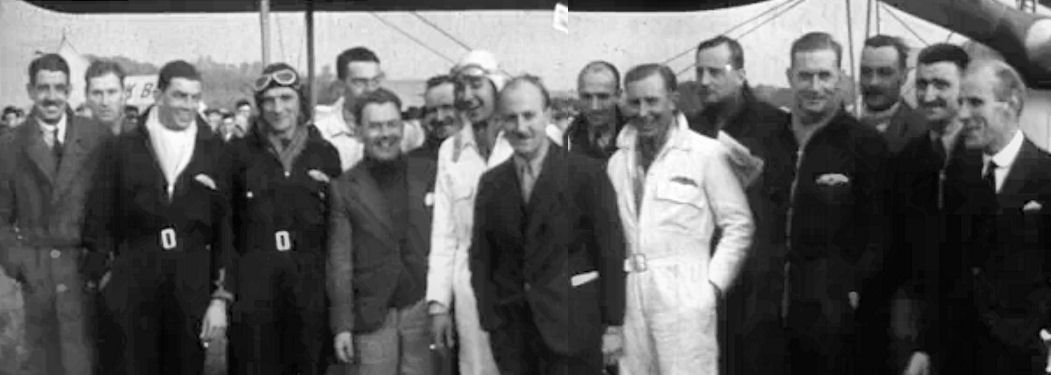
Far and away the largest of the European enterprises was Sir Alan Cobham's Air Display which, under its initial title of National Aviation Day, commenced its first tour of Great Britain in 1932. I joined the organisation at the beginning of 1935, when the aircraft were undergoing their winter overhaul at Ford in Sussex.
The following year, 1936, the name was changed to C.W.A. Scott's Air Display, although most of the aircraft and personnel remained unchanged. The business name of the organisation was actually Trafalgar Advertising Ltd (and it was indeed a business) with its headquarters in a small and far from lavish office near Trafalgar Square in the heart of London.
The programmes the public got were very good, varied and slickly produced air displays, twice each day in the afternoon and evening. With British Summer Time it was light until after 10pm, and later still in the northern latitudes. I can remember being able to read a newspaper at midnight, near Thurso at the northern tip of Scotland.
The shows were also seven days per week. 'The Show Goes On' really meant something, because the name of the game was selling joy-riding.

The opening mass formation flight over the local town did not see an engine start up until every available seat for the flight had been sold - excepting the complimentary seat for the local Lord Mayor, beamingly oblivious that the pilot of the 'Giant Airliner' would cheerfully strangle the Mayor with his own heavy gold chain of Office. Tickets were sold in different colours at different prices, the Ringmaster M.C. at the microphone being singularly adept at guaging the optimum starting price for any locality. There were times when the Avro 504s were down to three shillings and sixpence. Towards the conclusion of the evening shows it was customary to reduce prices, the fundamental function of the display being to produce the maximum revenue before the public departed the flying field.
The aircraft loaders retained the public's tickets, for pilots were paid on a retainer plus ticket commission. At the end of the day, any sounds of disharmony could usually be traced to the balancing of money receipts with ticket returns.
Putting the Show on the Road
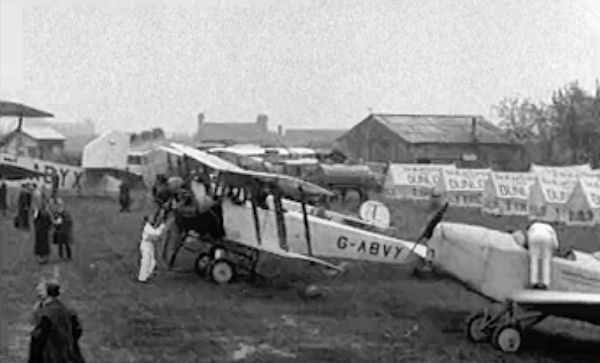
Behind these magnificent men in their flying machines, and notwithstanding the rather unimpressive office which kept tabs on activities (and was the post box for our mail), the whole enterprise was large and complex.
Months ahead there was a reconnaisance party which dealt with local authorities, advance publicity, and farmers. The utilisation of likely fields might be dependent on crops, hay - or the local annual Morris-dancers festival. This sort of thing could see us flying up to 200 miles between displays, and was hell on earth for the road transport people. They had to pack, travel overnight and set up well in advance of the first show. The store truck was always [having] a problem which, on short transits, usually delayed its morning departure. No matter how many likely spare gaskets we had in our tool-boxes, there was often a last-minute something that only the stores truck could supply.
Just prior to D-Day there was the advance party, led by a genial glad-hander named Jerry Hancock, who arranged hotels for the pilots and promised the farmer that he would make a fortune when he sold his paddock as a future airport (which at the time lacked the imposing grandeur of 'International'). Jerry also organised publicity posters, slides at cinemas and supplied photo blocks plus press handouts to local newspapers. Of which there were hundreds. One of my tedious chores (until discovering the art of delegation by flattery) was pasting the names of newspapers on each side of the Wolf sailplane's plywood fuselage, and unsticking these 10 feet long posters every evening.
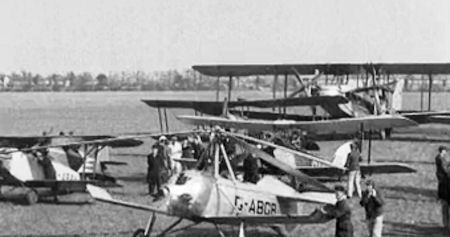
For their own posters, no newspaper ever had any type less than 12 inches high.
On the display day there first arrived the screeners (a party of four, sometimes plus local casual labour) who put up the steel stanchions and incredible lengths of canvas, which prevented people from getting a free look from adjacent roads or public land. We also had two policemen, retired cops of immense solidity, who discouraged kids from tunnelling through hedges, and who established a rapid rapport with the local Constabulary, ensuring that motorists did not get free views by standing on the roofs of parked cars.
The 'loudspeaker van' was the centrepiece of the show, parked just inside the barrier wire by the ticket tent. The driver of this van was one of the hardest worked people on the show. He looked after the loudspeakers, constantly misbehaving microphones, the amplifier, the gramophone records and the charging of a massive array of batteries supplying public address power.
The Business Command Post was the 'Gate Van', almost impregnable and thief-proof because that is where the money was kept. A staff of four gentlemen could be kept extremely busy on a good day, selling entry tickets for people and cars.
Then there was the refuelling wagon with a team of two. In both 1935 and 1936 this was a huge Leyland six-wheel tanker supplied by National Benzol. All engines, vehicle or aircraft, as was frequently mentioned on the loudspeakers, ran on National Benzol. Free, of course. I have the recollection that some of the engines, the Jupiters and the Armstrong Siddeleys I think, had the carburettors jetted for 80-20 petrol benzol mix.
Wings and wheels, on the same gratis basis, were lubricated by Castrol in various grades. To minimise the quantity of reserve oil carried by the stores truck, Castrol in 4 gallon drums was delivered to each display site in vast quantities by the local depot, who also collected unused drums the next morning. These drums were stacked in pyramids, Castrol label to the fore, at the car promotions and at strategic places on the flight line. The public could actually see the superb unction being poured into aircraft in which they soon intended to fly. The Castrol Sales promotion team's confidence in their marketing technique was well justified.
There were also the franchisers, who were many and varied. They paid a fee and were free to make their own profits, transporting and erecting their own tents in their own transport. The major one was the canteen marquee which, by arrangement, had prices for staff more reaasonable than the sliding scale applied to the public. Other franchisers came and went, some only operating in a restricted locality, but the steadies werfe a museum of scale models, programme sellers and vendors of display souvenirs, like brochures.
With the exception of the fuel tanker, all transport in 1935 was supplied by Ford, and in 1936 by Vauxhall/Bedford. In each case those companies, with their local agencies, had an all-model motor show and sales promotion at every show.
Part 2 - Keeping Them Flying
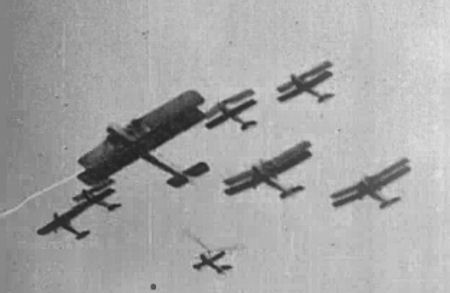
From time to time, other itinerant joy riders would join our display, usually in particular areas like the British South Coast in the holiday season. If they ran into maintenance problems we might get a better acquaintance with Monospars, Short Scions, Klemms, the Handley Page W8B "Prince Henry" with two Rolls-Royce Eagle engines, and even a three-engined Armstrong-Whitworth Argosy amongst other types.
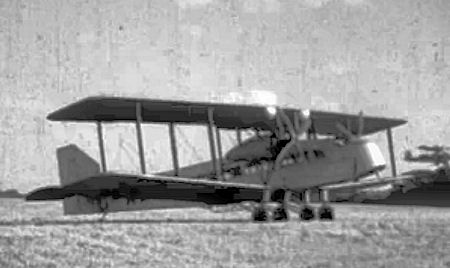
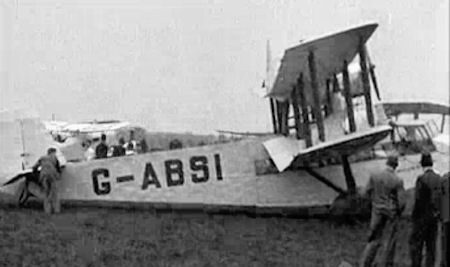
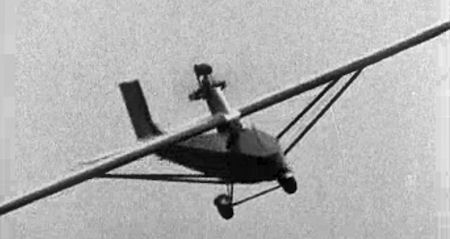
Relying on memory the aircraft in 1935 were: the Handley Page Clive (two 550hp Bristol Jupiters), Airspeed Ferry (two Gipsy II and an inverted Gipsy III on top), two Westland Wessex (three Armstrong Siddeley 5-cylinder Genet Majors), three 3-seater Avro Cadets (A/S 7-cylinder Genet Major), Tiger Moth (Gipsy Major), Avro Tutor (A/S Lynx) one Avro 504N (A/S Mongose), BAC Drone (Douglas Sprite converted motorcycle engine) and Schemp-Hirth 'Wolf' sailplane. This glider, aero-towed by one of the 504s, did quite vigorous aerobatic displays every day for two seasons, which is close to 700 aerobatic sessions for a wooden glider designed to the German strength requirements of 60 years ago. However, a bigger drawcard than the glider was the first appearance of the 'wingless wonder', the Type C30P Autogiro (7-cylinder Genet Major) flown by 'Crasher' Ashley. An underserved nickname, but he was a 'new boy', who had just gained his commercial licence.
In 1936 the organisation, and about 90 per cent of the personnel, was not much different to the previous year. The Clive had been retired after carrying 120,000 happy fare-paying passengers, and a not so happy me on one memorable occasion. Both the Wessexes and the Drone also rested from the rigours of touring. We got another Airspeed Ferry and the 1935 Ferry had its two outboard Gipsy IIs replaced with Gipsy Majors salvaged from a DH84 Dragon, which had ditched in the English Channel. We also got the 1936 star turn, a Flying Flea with a liquid cooled Ford 10 engine conversion, and, very briefly, before it set out for South Africa, a Hillson Praga. This Czech aircraft built under licence was unspinnable, and is worthy of some reconsideration today. The Praga engine, made under licence by Jowett Cars, was not very satisfactory.
Inside the wire, and sheltering from the sun or wind at one end or other of the flight line, was a most important person in the operations. The Time-Keeper. Most usually a young aviation enthusiast of some means, who could spare a few weeks before going to Uni or joining one of the aviation firms. For back-up there was 'Atlas' - of whom more anon. The time-keeper logged to the minute the take-off and landing times of all aircraft; a task demanding intense concentration on busy days. The purpose was serious. Pilots needed the time for their logbooks, and we needed times for the maintenance logbooks.
The display ringmaster, or MC, the man at the mike, was the golden-voiced Roy Arthur, the stage name of a theatrical pro who had trod the boards and made the big-time at the 'Little Twittering Colosseum'. Whenever even Roy's eloquence failed to move people in the direction of the ticket tent, his place would be taken by the Display Manager - who knew how to persuade Mrs. Bloggs to purchase a right of entry to the Giant Airliner. Whereupon, three other ladies would say to their husbands, "If that Sadie Bloggs flies in an aeroplane we will never hear the last of it". With the sluice gate satisfactorily open, Roy would again take over the mike.
The Manager could charm lobsters into joy-flights. He was never known to set foot in an aeroplane, his previous service in World War I as a kite balloon observer having apparently exhausted his capacity for enjoyment of airborne aviation.
Then there were the pilots, nearly all ex RFC or ex RAF short service commission. Extremely competent, as some of the paddocks used in Scotland and Ireland very nearly required a miniature railway to put them in perspective. There were mishaps, but in two years no fare-paying passenger was even scratched. Operations were intensive, By the end of the season the two Ferries had logged well over 10,000 flights with up to ten passengers at a time. While the flights were probably less than five minutes at a time, it is a lot of full-power take-offs and landings on fields which frequently left a lot to be desired.
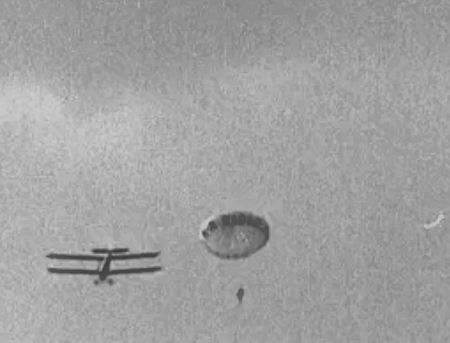
In 1935 there were two parachutists, Ivor Price and Naomi Heron-Maxwell, who did pull-off releases from two platforms at the rear outer interplane struts of the Clive. In 1936 Al Harris, who had done some of the jumps in 1935, did the parachuting from an Avro Cadet. He also did joy-riding in the Cadet too.
The engineering staff also featured ex-RAF members, but also included engineers who were on loan from Bristols and Armstrong Siddeley, and who were really excellent. They had all started on the bench, gone through manufacturing, the view room, the test beds and overseas service. Their ability to inform was superb; describing aspects of super-charging with a beer-soaked finger on a table top is a fine art.
Backing up the maintenance staff were the loader/cleaners, one per aircraft. The Avro 504s required ladders for passenger access. One of the important functions for a loader was to grab the wingtip of an incoming brakeless aircraft and turn it so that its tail was towards the crowd. The loader had to be particularly alert that excited disembarking passengers, mad keen to join their admiring friends, did not run into rotating propellers. One woman ran unscathed through the prop of a Short Scion at Weston-super-Mare, which proves that there was something to be said for the reduction gear on a Pobjoy engine.
Maybe, about twice a season, we would get an aircraft into a hangar. There is a vague memory of Joe King doing a solo flight to Blackpool on two engines so that we could change the upper engine on a Ferry. Otherwise, maintenance was distinctly an open air affair, rain or shine. Engines and undercarriages had a hard life. The Avro 504N wheels had plain bushes requiring greasing more than once on a busy day, and the stores truck carried a fair weight of spare bushes.
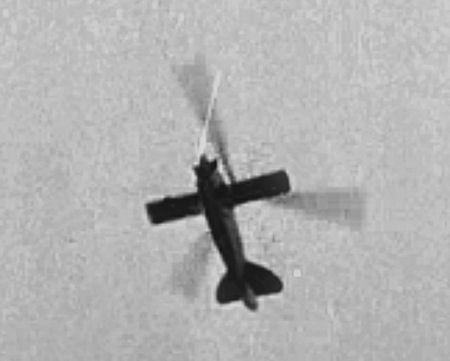
Most major spares were held back at base, Ford Airfield in Sussex. And also some other hibernating aircraft, such as the Blackburn Lincock, with an empty weight suggesting it was made of solid metal; stub winged C19 autogiros, out of favour due to their notorious ground resonance 'dance of death' and a DH9 with a Siddleye Puma engine which had been used in flight refuellling experiments. All in the care of an elderly faithful retainer.
.jpg)
From a remote outpost of the corporate empire there was sent a telegram asking the faithful retainer to ensure the first available passenger train carried northwards a spare tailskid for the Handley Page Clive - a large lump of ironmongery terminating with a heavy steel disc about the size of a very large soup plate.
Repeated journeys to the nearest railway station revealed no Passenger, Fish or Freight trains in any danger of exceeding their axle loading limits with what we needed. Expediency overcame protocol, and the aged retainer was phoned a message of some urgency. "Aah", he said, "so them things we have is tailskids, are they? Oi calls them draggers".
Part 3 - The Funny Side
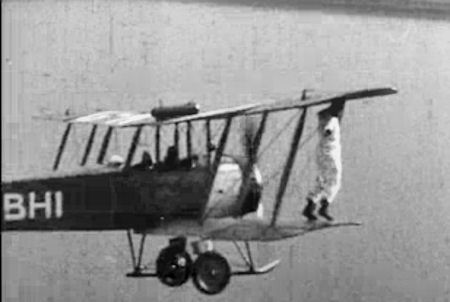
The 1935 display, in July and after its tour of Ireland, split into two divisions. One with the Clive plus a Grunau Baby glider flown by Eric Collins, and the other tour with the Airspeed Ferry G-ABSI. In less than six months of the summer season 244 locations were visited, only sixteen of which were established airfields. A few places were two day events which meant four shows. There was just one day off, presumably due to weather. So, roughly speaking, I participated in around 340 displays during the first year. There were few towns that didn't get a display within walking distance, car ownership being sparse in a recovery period after a severe economic depression. The places visited ranged from Thurso in the north of Scotland to Penzance near Land's End in the south, and from Lowestoft in the east coast to Tralee in western Eire.
There was one break from circus tradition. The overture music on the public address system was not the standard 'Entry of the Gladiators'. It was a then equally popular march 'With Sword and Lance'. There was however a very firm adherence to long-standing circus tradition. We had comedy items, about five different routines which varied slightly. There were never more than two in the same show. Their timing would be altered as necessary - sometimes to divert the audiences at short notice, such as some lapse of expertise like a taxying mishap. Or the charming lady who flew the Wolf sailplane, Joan Meakin, taking advantage of thermals to cruise around without an engine. This drove the Manager into a state of near beserk rage. Nobody was going to purchase a flight in an aeroplane when they continued to witness a near miracle performed by a flying machine without an engine. Bring on the clowns, quick!

Martin Hearn, Geoff Tyson and Flt Lt H C Johnson in 1934
The comedy routines were masterminded by Martin Hearn who had done the wing walking in earlier years until it had been prohibited by the Air Ministry. He continued to do it in Eire and it was every bit as impressive as may be seen on Oshkosh videos today. Martin also ferried the Tiger between locations since Geoff Tyson had to ferry the Avro Tutor. Aidng and abetting Martin (apart from contributing piloots) were a droll Cornishman called Charly Craig, and a thick-set middle-aged dwarf from a theatrical casting agency, who insisted on being known by his stage name 'Atlas'. To strangers he preferred to be introduced as Mr. Atlas. The fourth comedy conspirator had been played the previous year by an engineer named Roy Bonner, who conspired that I should take over his part on the promise that he would explain to me the intricacies of master and articulated con-rods. So, twice a day, I became a drag queen, nerly half a century before coming out of the closet became prurient entertainment on TV. Martin Hearn said I was well suited because this absolute star part highlight of the display required agility, and the possibility of developing humour combined with the dim-witted misguided idealism of wanting to be an aircraft engineer. Routines are hard to explain in words. One of them was 'The Wedding'. The major prop was an open four seater bullnose Morris Cowley, very dilapidated. When Charly drove it from place to place he was often stopped by the police. The vehicle would emerge from the end of the field, driverless, because Charly was lying on the floor getting steering directions from the happy bridal couple sitting up on the folded hood at the rear. Martin in the top hat and me in the bridal gown playfully bashing Martin with the bouquet should his advances be too amorous. The vehicle stopped well outboard of the speaker van, with its starboard side towards the crowd and the man on the mike remonstrated about obstructions on a famous or future famous aerodrome. Charly would slide out of the left front seat, to appear as a grotesquely dressed yokel wanting the car and the bridal couple off his land. The man on the mike called for serious action and Geoff Tyson took off in the red and white chequered Tiger Moth.
.jpg)
There was much funny business and Charly pulled a revolver (loaded with blanks). His second shot was fired at point blank range into a large steel tray on the starboard running board filled with petrol-soaked rage. This produced a most impressive blaze with flames about six foot high and lots of smoke. I ran around to put it out by waving my skirt, exposing bright scarlet knickers, always good for a laugh, and from the speaker van ran Atlas wearing a policeman's hat and bearing a Pyrene fire extinguisher. With a few pumps of Pyrene, well publicised on the speakers, Atlas put the fire out in seconds. Extinguishing the fire was the signal for Geoff Tyson to start his flour bomb attacks, french chalk in paper bags. A twice a day demonstraion of low flying with the public never in the slightest danger. The bombing was combined with more funny business, running and cartwheeling over one another until the Tiger gave a quick blip on the throttle meaning bombs exhausted. Atlas got the gun and, with Charly at the wheel, chased the discomforted bridal couple off the end of the flight line. Clutching the gown around my waist, and air-cooling those scarlet bloomers, I could in those days do a forward running somersault every time the gun fired. It sounds a bit backwoods hick today but the crowds loved it and it was, of course, a magnificent advertisement for Pyrene fire extinguishers.
Geoff Tyson, who recently died at the age of eighty, after WWII attained some fame as the last pilot on the 10-3engined 'Princess' flying boat. We had occaasional visits from N.S. Norway who, together with Hessell Titman, had designed the Airspeed Ferry. In addition to seeing how the Ferries continued to stand up in service, Mr Norway was interested in all display activities. Some years later he became more famous with his first best-selling book 'The Pied Piper'. As a write he used his initial name, Nevil Shute. He also wrote 'Round the Bend', which features the air circuses and the comedy items in the opening chapters.
Part 4 - The Giant Airliner
.jpg)
'Giant Size' was a phrase much used by advertisers in the years before 'King Size' became a more vogue term to encourage the selling of marketing articles.
Thus, it came about in the 1930s that any aircraft with windows in the sides, like a Fox Moth, became an airliner, and if it had a fair few windows it was a 'Giant Airliner'. So the residents of any small township like Much Babbling-in-the-Bog would be eager to see, and perhaps equally eager to sample, the visitation of a large aeroplane which clearly ws intended to prove that their parish was a likely hub for all future air transportation within the British Isles.
The one and only Mark I Handley Page Clive, with its ability to get into and out of small but smooth paddocks, ideally lived up to the advance publicity. Built in 1928 as a troop-carrier conversion of the Hinaidi bomber, with a higher fuselage, it had commenced its civilian career in 1932 giving joy-rides with Sir Alan Cobham's National Air Day air displays. It was also used as a tanker aircraft in Sir Alan's flight refuelling experiments.
My acquaintance with the Clive started in January 1935. It was undergoing C of A overhaul together with the Airsped Ferry, my previous contruction experience on the latter having led an earlier foreman into persuading me to join him on the air display staff. The Clive had sixteen passenger seats, in the best vintage wickerwork. Although they had safety belts it is very doubtful if those seats, and their floor attachments, would come within cooee of modern airworthiness strength requirements. Nevertheless the Clive in four joyriding seasons carried 120,000 passengers without a scratch. Even if it carried a full load each time, which is far from correct, it works out to about 11 take-offs and landings per operatng day on that curious landing gear.
The Clive was withdrawn from service at the end of the 1935 season.
A Different sort of Straight and Level
Within about a week of the 1935 tour starting, a display was given at a location east of Birmingham, which may have been Coleshill. At the conclusion of the day the Clive, like all the other aircraft, was refuelled by the National Benzol truck so it could fill its tank at a depot and appear in time wherever the next display was scheduled on the itinerary.
Topping up with oil was left as a staff warm-up exercise for the next morning. The Bristol Jupiters being oil-cooled in addition to any air which might waft across their cylinders, meant carrying 4 gallon drums of Castrol, as advertised, two at a time by the wire handles on top of the drums. The Bristol rep., Reggie Knapp, with an eye conditioned by experience in South America, Africa, Japan and elsewhere, ensured that what had to be done was indeed done. Capt. H C Johnston who, given an aeroplane small enough could have flown through a fishing net, surveyed his modest load with an experienced eye. Reggie suffered from claustrophobia, so always flew in the open cockpit with the Captain. The toolboxes, passenger boarding steps, cleaner's ladder, the loader, Ted Watling, myself, and a large ex-London Constable who had joined as a display policeman only the previous day and had never flown in an aeroplane before, occupied the passenger cabin.
The field was rectangular and had lent itself to the long dimension on the previous day. But not this particular morning. A very brisk westerly was blowing. With his long experience on Handley Pages of various types, the Captain knew that resistance to cross-wind component was not the outstanding feature of the Handley Page drawing office. He therefore opted for a diagonal compromise in take-off direction.
As usual, the Clive got airborne in a very short distance but, with a massive thud and yaw, uprooted a smallish tree with the outer starboard lower mainplane. The Clive continued with a slight climb and a series of mild yaws. Reggie overcame his claustrophobia long enough to come aft and advise that the aileron controls were jammed. This didn't mean anything to the policeman, but his gazing out of the window at a tree festooned around an outboard interplane strut, and the shedding of leaves in the breeze, had obviously conveyed to him that all was not well.
Fortunately, just a few miles ahead, and dead on track, lay Castle Bromwich airfield which at that time was also an RAF station. With as expert a piece of flying as one is likely to see, and in gusty conditions, Hugh Johnson maintained lateral control by judicious applications of rudder, and landed at Castle Bromwich dead in line. No runways in those days. Possibly the RAF, seeing so much flying vegetation, thumbed through their copies of 'Macbeth' to refresh their minds about the portent inherent in the Forest of Dunsinane.When, with feet on comforting ground, we stood and surveyed this botanical air-brake, Captain Johnson, a man of few words, said "Jesus of Nazareth" and strode off with signs of displeasure. Shortly afterwards the policeman also departed the scene.
The tree trunk was about five inches in diameter where it had broken off. It had bruised the front spar. A lower bough had bent the push-rod operated aileron horn 90 degrees outboard, effectively locking the aileron control, and the rear spar was damaged beyond repair.
Thanks to Captain Johnson's old boy network we got excellent assistance from the RAF. Back at Ford Airfield there were enough surplus Hinaldi wings to cover a football pitch. One was rapidly sprayed silver over its Mesopotamia drab and, with other spares and stores, despached on a semi-trailer with escort because of its size. We were flying again three days later. The biggest job was painting the missing registration under the replacement wing.
Part 5 - The Wingless Wonder


The above wording was the official air display name for the C30 Autogiro, spelt with an 'i' by the company that developed them. Autogyro, with a 'y', appears to be the generic name for that type of aircraft. Among the predominantly male display staff it was frequently referred to as the 'whirling spray'.
Previous displays had operated the earlier C-19 model with a four-bladed rotor, twin fins and a low wing with upturned tips. The C-19 has a susceptibility to ground resonance, the so-called 'Dance of Death', causing a number of incidents resulting in major damage, but otherwise harmless to occupants.
The C-30 was different. It had a three-bladed rotor, no wing, a more powerful 140hp engine with a rotor run-up clutch, a robust undercarriage and an entirely different control system.
At Phoenix Park in Dublin the autogiro made more than 100 joy rides on the same day (at a premium ticket price too), the Display Manager going not so quietly mad every time that the aircraft stopped for a blade drag check.
On one ocasion at, I think, Cannock Chase in Staffordshire, Captain Ashley was giving his usual solo demonstration of the wingless wonder. Tailwheel on the ground, wheels nearly two feet off the ground, the aircraft rolled along the flight line looking like a parying mantis with its antennae in a spin. The area was prone to mining subsidence. At the end of the line the right wheel struck a vertical wall of local landscape, concealed by long grass. The gear was broken off and the autogiro fell on its right side as it came to a sudden stop. As the still spinning rotor went round, the landscape repetitively sheared off the blades - about a yard at a time, the bits flying in all directions.
The Show went on. We had a replacement autogiro the next day, on hire while YH departed for major remedial surgery. Which didn't take long either, Display Management being somewhat sensitive to any sort of cost. Particularly hire costs.
-
-The Aviators
The Aviators
-
Allen, Helen Naomi
Helen Naomi Allen
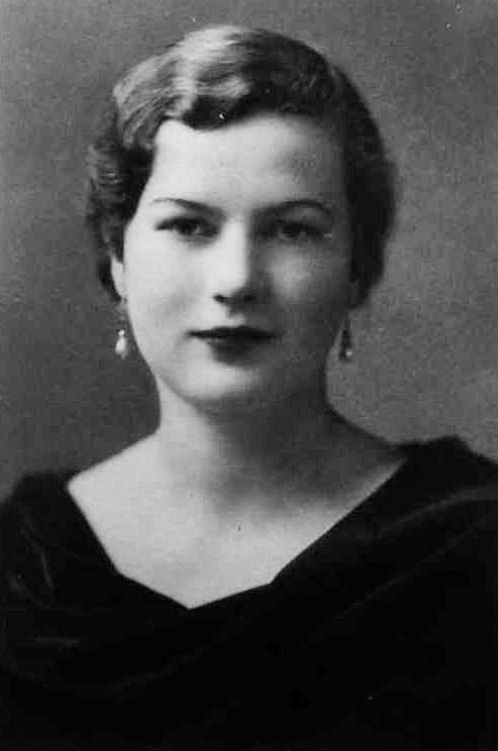 RAeC
RAeC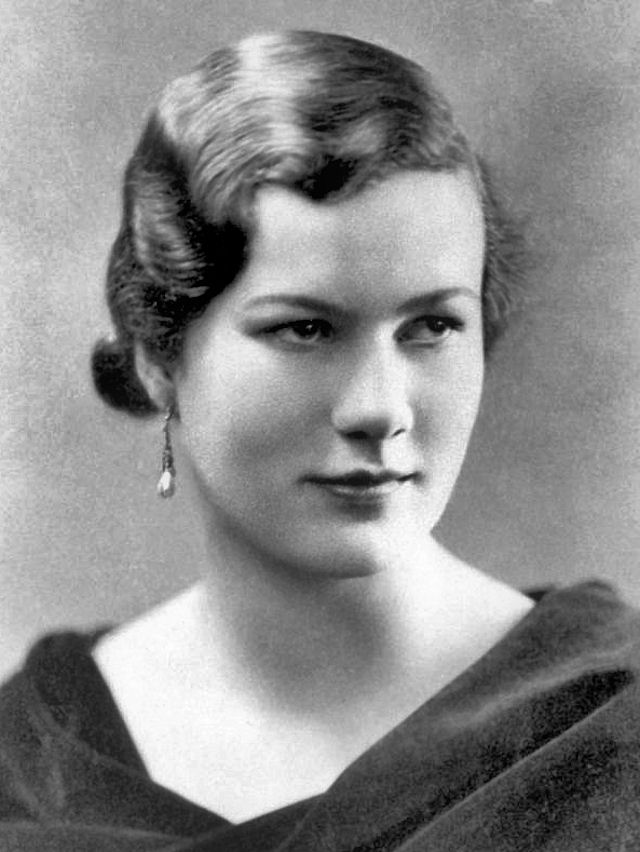 1934
1934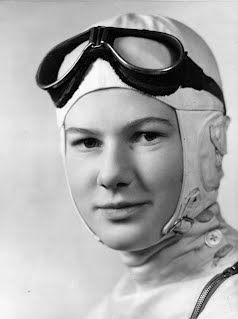 with Cobham's Flying Circus
with Cobham's Flying Circus...my mother-in-law was 96, so her memory may not have been what it was.
I mentioned I was going to the ATA Museum. She said "I met a ferry pilot a few times, she was Mrs Allen, and she flew planes across the Atlantic".
"Oh yes", I thought "No ATA women ferry pilots actually did that, but anyway..."
"Really" I said.
"Yes, she came to visit her mother-in-law who was our neighbour, Kitty Allen. This was when my sister worked at Bletchley Park."
"Right", I said, thinking "OK, there were 2 Mrs Allens in the ATA..."
"Yes, it was terrible how her husband died. It was after an operation. Apparently it was quite a straightforward operation, he woke up, said 'Hello Darling' and then promptly had a heart attack and died".
"OK", I thought, Helen Naomi Heron-Maxwell's first husband Mr Allen died in... let me see... January 1939, after they were married in... March 1938..."
"Maybe Helen or Naomi Heron-Maxwell?", I said.
"That name sounds familiar. Her family were very upper-crust, you know. Very well-connected. And another thing, who was it lived at Sissinghurst?" (Which I think signified the end of that part of the conversation).
So, I searched the Times Archive. Good grief, in 1939,
"ALLEN. On January 23rd 1939, in Austria, following an operation, FRANCIS CECIL HOWARD, adored husband of Naomi (nee Heron-Maxwell) and son of Mrs WHR Allen of Periwinkle, Long Acre Lane, Sisley, Sussex, aged 34"
And moreover, I discovered that Naomi moved to Los Angeles in 1948, married again, divorced and then moved into Leisure World in Laguna Hills, California, dying there in 1983.
Which is exactly when we lived in Mission Viejo, California - a few miles from her. If only I'd known!
(Mind you, Owen Cathcart Jones only lived a few miles in the other direction - if only I'd known, again!)
So there you go. (Nearly) a brush, or two, with dramatis personae...
-
Fielden, Earl Bateman
Capt. Earl Bateman 'Safety First' Fielden 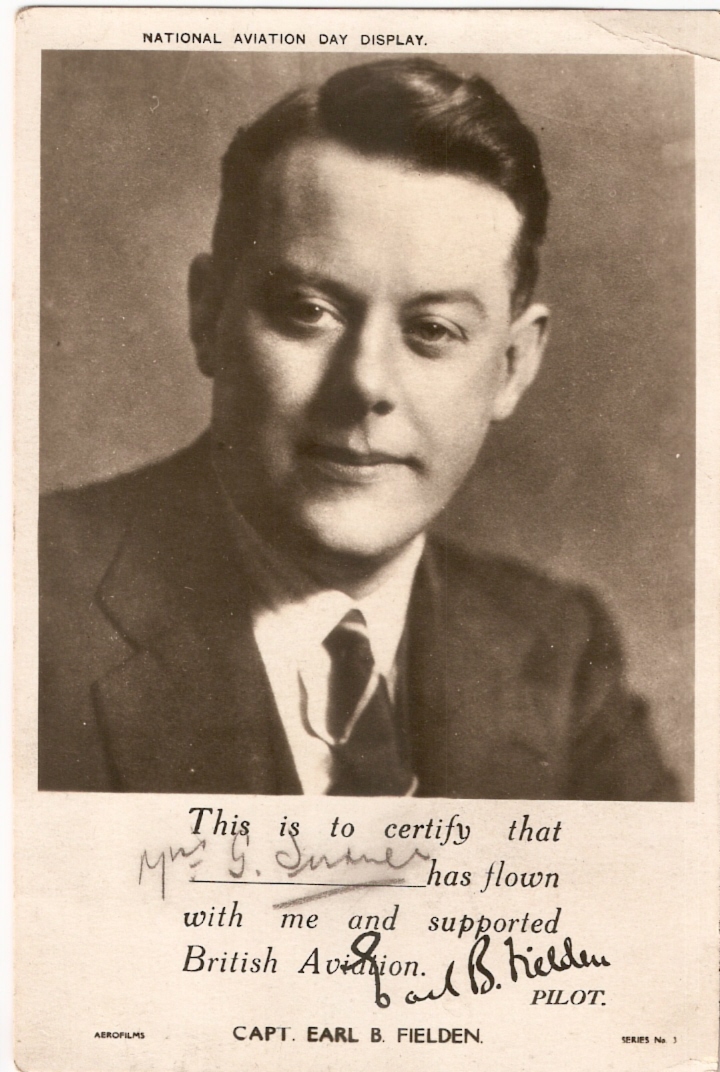 via Phillip Jones
via Phillip Jonesb. 14 Oct 1899, Shipley, Yorks
May 1938: "Cdr. E. B. Fielden, of British Airways, has now flown over 100,000 passengers without so much as bruising the very tenderest of them. A lot of his flying was done in the early joy-ride days, operating from small fields, and when chief pilot to Sir Alan Cobham's circus he once took up 768 people in a day. "
Just shows you can't believe all you read: August 25, 1933, "TWO MEN TRAPPED WHEN 'PUANE CRASHES. Pilot Jumps Clear In Time. Three airmen had remarkable escapes when an aeroplane crashed in arriving from Kidderminster for the Scunthorpe (Lincolnshire) hospital air pageant (BHAP) at Ashby yesterday. They were: Captain E. B. Fielden. of the Royal Club, London, the pilot; Mr Clifford Jones, of Blackwood; and Mr Frederick La Croix, Finchley, London. They were taken to Scunthorpe Hospital, but Captain Fielden was not detained.
The aeroplane was about to land when it got into difficulties and crashed into a field of sugar beet near the ground where the pageant was held. In striking the ground the 'plane toppled over but Captain Fielden managed to jump out. Mr Jones and La Croix were trapped in the cabin, but were soon rescued by Captain Fielden and officials who rushed from the pageant ground. On inquiry at the hospital early this morning it was stated that neither of the men who were detained appeared to be very seriously injured.
Captain Fielden had a narrow escape in September, 1931. when an air liner, of which was the pilot, crashed in flames near Moortown Golf Course in the east Riding of Yorkshire. "
He later 'transferred' to the British Hospitals Air Pageant, (a rival organisation which Alan Cobham regarded as rather a scam), together with Charles W. A. Scott, the Hon. Mrs. Victor Bruce, Pauline Gower. Dorothy Spicer, Capt. R. H. (All-weather) Mclntosh, Capt. Phillips, Capt. Rollason, Flt-Lt. J. B. W. Pugh. Flight-Lieut. A. G. Hill and Col. FitzMaurice, who was the first to fly the Atlantic from east to west.
Later a Wing Commander in WWII; DFC in 1944 for having been responsible for the movements of loaded transports during the Wingate airborne invasion of Burma.
His son, Aircraftman 2nd Class Stanley Earl Spensley Fielden (RAFVR) was killed 8 Mar 1943, age 18.
d. Feb 1985 in Exeter
-
Meakin, Marjorie Joan
Marjorie Joan Meakin 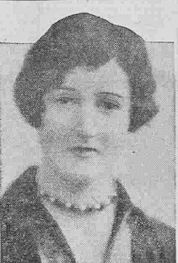
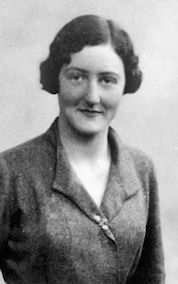
b. 7 Jan 1910

6 April 1934, Derby Daily Telegraph: "DERBY PRIDE IN WOMAN'S GLIDING FEAT REPTON ESCAPADE RECALLED Miss Joan Meakin, the 24-years old airwoman, who yesterday completed a record flight in a towed glider from Cologne, Germany, to Heston Aerodrome, lived for several years at Repton.
She was nursed from birth until she was nearly 10 years old by Mrs. C. Williams, of Wolfa-street, Derby, who is well known locally as an enthusiastic hospital worker and flag-day organiser. Mrs. Williams told a "Telegraph" representative that she was with Miss Meakin's family as nurse for more than years, during which time she had complete charge the children.
UNCLE AT MARSTON Miss Meakin, she said, was born at Elford, near Tamworth, but when she was two years old her family removed to Bower Hill, Repton, where they lived for several years before going to London. Miss Meakin is a niece of Mr. J. M. Spurrier, of Marston-on-Dove, said Mrs. Williams. Her mother, Mrs. J. H. Thurston, occasionally stays at Marston and visits Mrs. Williams at Derby.
As a child, Miss Meakin was exceedingly mischievous and daring. When she was about five years old she ran down the hill from her Repton home and climbed to the top of a tall copper beech tree, and then challenged her nurse to find her. "Although she was such a tom-boy. she had a very sweet disposition," said Mrs. Williams. " I am extremely proud to know that she has achieved such fame."
BROTHER KILLED Among the other children Mrs. Williams nursed was the eldest boy, Peter, who, as an R.A.F. cadet, was killed some years ago in a 'plane crash. Peter Meakin attended the preparatory school at Repton. When Miss Meakin insisted upon taking up flying, her step-father, Mr. J. H. Thurston, tried to dissuade her for her mother's sake. When she persisted, however, he promised to buy her a glider if she was the first woman to glide over the Channel.
During her daring glide, Miss Meakin was towed by a German Klemm machine. She experienced good weather except for one patch, where she was thrown from her seat several times by the " bumpy " air.

TO JOIN AIR CIRCUS She intends to join Sir Alan Cobham's air circus in a short time, and to make gliding her career.
Miss Meakin's father is Mr. Henry M. Meakin, of The Soho, Burton. Mr. Meakin is a representative for the firm of Messrs. Strauss, the London barley and hop merchants. Mr. Meakin's father was the owner of large maltings in Burton several years ago, known as Meakin's Maltings, now occupied by Messrs. R. Peach and Co., Ltd., Burton Maltings."
She wrote to Sir Alan Cobham in the early 70s: "It was the excitement, and freedom, and comradeship, and the sheer fun of it all that I adored, living the life of a gypsy, moving off each day to a different town - everyone keen and happy.... Now, forty years later, were it possible, I would join the Display again tomorrow to experience the thrills of seeing Geoffrey Tyson flying upside down so low that the top of his rudder parted the long grass, or Jock Mackay crazy-flying..."
Joan married Ronald Price, and eventually they retired to the Isle of Wight. She died there in November 1977. "A calm and intrepid spirit lay behind the warm personality of a really charming girl who was loved and respected by all who knew her". -
Phillips, Percival
Capt Percival Phillips 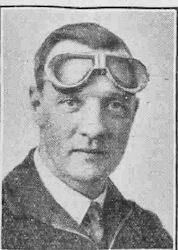
Western Morning News - Thursday 31 January 1935:
ST. AUSTELL PILOT HURT 'Plane Crash In Hospital Grounds CRITICAL STATE THIS MORNING
PERCIVAL PHILLIPS, M.C, St. Austell, was seriously injured when a two-seater aeroplane which was piloting, making forced landing in the dark, crashed into the grounds of Springfield Mental Hospital. Lower Tooting, London, S.W., last night.
He was first taken to the Springfield Hospital, but was later transferred St. James Hospital, Balham, where it was stated early this morning that he was in a critical condition, with a fractured skull, a broken nose, broken leg, and other injuries.
His passenger, Mr. James Edward Fry, of Gloucester-terrace, who received injuries to tbe left eye and nose, and was also transferred to the Balham Hospital, was later able take his discharge. The machine, which was owned by Air Services, of Croydon, and was making a flight round London when the mishap occurred, was slightly damaged.
WAR SERVICE R.A.F. Capt. Percival Phillips, whose London address was given as the Aerodrome Hotel, Croydon, lives in St. Austell. During the war he served as a pilot in the Royal Air Force. Coming down the Turkish lines in Mesopotamia, he was taken prisoner.
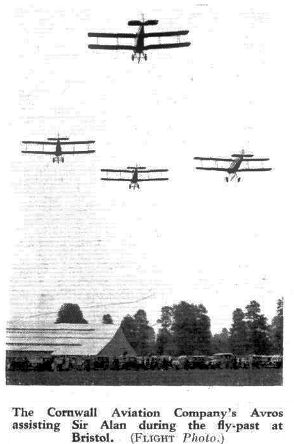
He is partner in the motor firm Messrs. Hill and Phillips, of St. Austell, and is senior partner in the firm of Cornwall Aviation Company, whose headquarters are at St. Austell. He has been one of tbe pilots in Sir Alan Cobham's Flying circus, and his acrobatic stunts in the air will be remembered by many from the West country who visited the circus. His wife last night informed Western Morning News representative that she had intimation of the accident from London. Mrs. Phillips is the elder daughter of Mr. H. Rowse, of the firm of St. Auslell auctioneers. There are two young children."
d. 1938:
"‘DEATH OF CAPT. P. PHILLIPS
FLIGHT greatly regrets to record the death of Capt. Percival Phillips, D.F.C., R.A.F.O., managing director and chief pilot of Air Publicity, Ltd. It appears that Capt. Phillips, on his way home to Heston from banner-towing work at Hull, put his 504 Avro down in a field at Gamlingay, between Bedford and Cambridge, in order to call upon friends for lunch. In taking-off afterwards in gusty weather the machine struck a tree top, hit the ground, and caught fire.
Capt. Phillips, who had been with Air Publicity since their inception in 1935, was formerly managing director of C. W. A. Scott’s Flying Display, and had safely carried many thousand passengers as a joy-ride pilot. During the war he had seen flying service in Iraq and elsewhere.
Last summer, flying a veteran Lynx Avro used daily for banner towing, he won the Devon Air Race. Those of us who met him on that occasion and elsewhere recall him as a particularly charming and modest man, with an almost boyish zest for flying which belied his 45 years. To his equally sporting and enthusiastic wife – who was his passenger in the Avro during the Devon Race, and on many other flights – and to his two children, FLIGHT extends most sincere sympathy in their loss.’" -
Rawson, Arthur Harold Charles
Flt-Lt Arthur Harold Charles Rawson b. 7 Sep 1896, Calcutta, India
British Army 1914-16; RAF 1916-21 & 1923-28; RAFO 1928-36
Test pilot (subs Chief Pilot), Cierva Auto-Giro Co, 1928-32
Involved in early helicopter experiments, including a helicopter promotional tour of the UK in Aug 1928, and of Europe (Paris, Brussels, Cologne, Dortmund, Hanover, Berlin & Rotterdam, incl dual with German Ace Ernst Udet), in Oct 1928
co-author,' The Book of the C.19 Autogiro' (1931)
staff pilot for Cobham's Flying Circus in 1932
RAF 1940-41
Died in WWII - 3 Jun 1941, crashed ½m North of Towyn Aerodrome attempting a forced landing after engine failure in Henley III L3284. He and AC2 Sharp were trapped in the aircraft, which burnt out.
Research: thanks to Steve Brew

